#I also like that they both have irregular emotions - they are men of extremes
Explore tagged Tumblr posts
Text

Gallery Piece of Montreal is how I think of Suder/Tuvok
#suder/tuvok#tuvok/suder#I know in canon Suder is reformed in one episode but I prefer the thought of Suder and Tuvok both having complicated feelings#for one another where Suder doesn't ONLY feel gratitude towards Tuvok#I also like that they both have irregular emotions - they are men of extremes#Tuvok has to keep his emotions in check or they'll overwhelm him and make him act in ways he doesn't agree with#(if he doesn't adhere strictly to nothing he'll feel everything)#meanwhile Suder's extremes are that 'I didn't like the way he looked at me' was enough for him to kill a man#I doubt his feelings for Tuvok (who both destroyed and saved him as a result of giving him a new life) would be entirely positive#I also prefer his slightly more sinister and inquisitive personality in the first episode he appears in - he's...toothsome#I like how he pushes Tuvok and makes him uncomfortable and presents him with questions he's never asked or points of view#he's never considered - his entire existence is confusing and intriguing and irresistible to Tuvok bc it's something he thinks cannot be#and despite himself Tuvok CAN'T entirely keep from being drawn in by him
5 notes
·
View notes
Text
Lilies of the Valley X

A/B/O!BTS x Reader
Flowers can have different meanings depending on the flower shape, color, and method in which they are presented. Lilies are my favorite for such a simple flower can have so many distinct meanings.
“Flower essences encourage gentleness and nurturing. And can also calm an overly aggressive person. However, some have the opposite effects.”
Release Date: 06/19/20 @ 7 pm
previously ~ next

YN couldn’t remember the last time she had a check-up. It must’ve been right before she presented when her physician had explained to her, that everything pointed to her sub-gender being an Omega and not a beta. Granted there had been little time for her to dwell on it with her parents outside the door, but it didn’t make for a favorable experience. Her suppressants hadn’t been handled by a doctor, but rather a nurse in a quick drive-thru clinic for which she had to pay $15 every month. Considering how reckless YN had been she went through the suppressants a lot quicker than she should, but no one ever asked any questions.
The place she was at now was a lot nicer and even had some omegas as nurses which YN hadn’t seen much of. The nurse had asked Hoseok and Namjoon to stay outside for privacy reasons and the alphas had encouraged YN to contact them if she needed anything. Now all YN could do was wait. For what she wasn’t too sure, but a health check-up couldn’t hurt. Her phone served as a distractor, as did Rosé:
Rosé: Long time no see…
YN: Sorry I’ve been mia lately. I’ve missed you.
Rosé: I’ve missed you too. Also, you’ve missed so much
Rosé: I met someone!
YN: Who??
Rosé: He’s a beta. A nice beta. I just kinda ran into him one day and we started talking. Isn’t it amazing?!
YN: Yeah, that’s great.
YN locked her phone screen and glanced around the room. On the door, there were the typical pamphlets one would expect all ranging from various topics: sub-genders, presenting, mating, and starting a family. Maybe she should’ve felt something when she looked at them, but YN didn’t feel anything. Not anger or disgust. Not happiness or excitement. It was still far too early in their relationship to consider any of those things. Can it even be considered a relationship? The men were much more invested in it than she was, but then again that was to be expected. They shared a pack bond and YN had only recently started warming herself up to the idea of being with them. It wasn’t like she had much of a choice in the matter, but at least she was thankful the seven of them weren’t pressuring her into anything. Even if they were rushing a bit.

The door opened to a nice-looking woman wearing a lab coat, on the pocket was embroidered: Dr. Jun. “Hello, nice to meet you. I’m Dr. Hyoseong Jun.” YN felt herself relax at the warm aura that seemed to surround the woman. “I’m YN. It’s nice to meet you too.” The doctor outstretched her hand and YN shook it. Jun motioned for YN to lay on the exam table and went through the procedural check-up before motioning YN to sit back up. Once YN was comfortable, the doctor took a seat in her chair, attention fully on YN.
“So, what’s the reason for today’s visit?”
Oh. YN didn’t exactly know, but she took her best guess. “I had a bad heat and wanted to see if I could change my suppressants.”
Dr. Jun nodded, focusing her attention on the computer. “Have you ever had a bad heat before this?”
YN swallowed, unsure of how to proceed. Rosé had warned her not to hide these things anymore, but YN was afraid of how people would react. Then, again this was a doctor and confidentiality did exist. “I haven’t had a heat since I presented.”
“Oh?” This caught the doctor’s attention. “Is it something biological? Are you irregular in your heats?”
“Um, no.” YN shook her head, taking a deep breath before speaking again. “I just took my suppressants so I wouldn’t have a heat.”
If anything, the doctor seemed even more perplexed at YN’s explanation. “Does your mate know about this?”
“No, I wasn’t with them. My mates have a pack bond and one of the alphas bit me during our first heat so-”
“The lead alpha, correct?”
YN felt time stop, her words dying on her tongue. “No. It was the youngest. We both presented at the same time and he accidentally bit me.”
Dr. Jun nodded, “Yes, but did you share the heat with the other members?”
YN scratched her head, the memories of her first heat were kind of muddled. YN did remember the other’s being there, but not participating in it. “They were there, but Jungkook is the one that bit me.” Seeing the doctor’s confused expression caused panic to swirl in the pit of YN’s stomach. “I was told that the bite of an alpha doesn’t heal.” Dr. Jun shook her head. “That’s only true if the mating bond is completed. Did you complete yours?” Dr. Jun had stood up at this point and was walking towards YN. Noticing her panicked expression and the slight shaking of her hands. “N-no.” A million thoughts were bouncing around in YN’s head as she tried to comprehend what exactly the doctor was implying.
“Only a lead alpha’s bite can’t be healed. If that applied to regular alphas there would be a bunch of mated teenagers running around. I’m sorry, YN but I have no reason to lie to you.”
No, that can’t be true. It couldn’t possibly be. If it were true then that would mean Namjoon bit her. It would mean Jungkook was innocent. It would mean…
“It wasn’t an accident.”

Kim Namjoon was an anomaly. Born to two alphas his birth had been a challenging one: his mother barely surviving it and Namjoon being born two weeks premature. It was a miracle his mother had even conceived, but with the help of hormonal treatments, they had just barely managed. Still, he was a strong child and exceptionally bright. The pros of having two parents of the dominant sub-gender or so he’d been told growing up. None of those things mattered to him though because Namjoon always felt incomplete. Like a part of him was missing and it haunted him. Nothing ever satisfied him because he had no one to share it with.
His parents encouraged him to make friends and even develop crushes, but it was useless. No one was ever up to par with his expectations - no one felt genuine. Eventually, Namjoon learned the hard way that self-isolation at a young age could have devastating consequences and made him an easy target. Not just among his peers but family members as well. Many found Namjoon to be unnatural - alphas should not be together, much like omegas shouldn’t - his family looked for every reason to pick him apart and by extension his parents. Namjoon felt that was a ridiculous stance in general: sub-genders shouldn’t determine who you’re allowed to be with. However, these were unpopular opinions and not ones he could voice as a child without extreme repercussions.
Namjoon kept his head down and avoided people, having few friends, and closing himself off until his eleventh birthday. That was the day Namjoon presented. Alphas didn’t typically present at such a young age, but he’d always been peculiar that day. It wasn’t until he was taken to the doctor and given suppressants that Namjoon finally understood why he was the way he was.
"He must be a lead alpha. Only lead alphas present at such a young age." The doctor had spoken to his parents outside, unaware that Namjoon had his ear pressed to the door. "It means your son likely carries the pack bond. He'll have multiple mates and will be able to sense them." Namjoon had been so shocked at that statement, he merely fell when the door opened. The second he got home he researched everything he could on pack bonds and how they worked. It might not be the case, as it was extremely rare, but it didn't hurt to hope. That was the one prevalent emotion that filled Namjoon: hope. He didn't know why, but it just made sense to him. He wouldn't simply find a mate like everyone else - no they were destined.
Being so rare there was limited information about it. Most of it is pure speculation as most individuals with a pack bond weren't open to sharing their experiences online or those that did claim provided little proof. It didn't really matter as it would be just two weeks later on the first day of school that Namjoon would feel it: the smell, pull, tug that innate feeling that drove him away from his parents and towards the center of the large crowd. Standing there with an old grey hoodie and scruffed converse was Min Yoongi. Namjoon's nose immediately picked up on the light scent of myrrh coming from him and a thought popped into his head. Beta? Though that was impossible as it looked like Yoongi hadn't presented yet, still, something inside Namjoon knew.
It seemed Yoongi was on edge, but the second their eyes met the elder rushed towards Namjoon embracing him in a hug. “I’ve been looking for you everywhere.” It left both their lips simultaneously and both seemed shocked until Yoongi laughed it off. “I’m Min Yoongi. Nice to meet you, mate.” Namjoon had never felt happier.
There was still an ache there, a craving, but Namjoon ignored it for the most part. Then, he felt it again. The pull. The need. Namjoon had stayed late after school working on a project when the soft thumps coming from the dance room caught his attention. Now had he been thinking logically, he might have noticed Namjoon was too far away from the dance room to possibly be able to hear music. But he did and so Namjoon followed the sound towards the room and towards Jung Hoseok. Who froze mid-step the second Namjoon threw the door open, there meeting was a bit different: instead of rushing to meet him Hoseok simply stood shocked. As seconds turned into minutes, the only words that escaped Hoseok where “the fuck.” Before rushing to meet Namjoon and nearly causing him to fall.
The second they embraced Namjoon’s nose rubbed against Hoseok’s neck and he felt a strong citrus scent. Alpha. Was his immediate thought, but he didn’t share it with Hoseok too caught up in the moment.
Slowly Namjoon began to meet his mates: Seokjin, Jimin, Taehyung, and Jungkook. All of them experiencing the same reaction upon meeting him and once they meet each other the connection only strengthened. The group stayed together for seven years and it was easy too considering the school they attended housed an elementary, middle, and high. Despite them knowing what they were to each other they simply remained close friends. Best friends. At least until Jungkook entered High school. By then most of them had presented and Namjoon's hunches had been correct. Still, something unnerved him and the others, though they would never directly mention it, they weren't complete.
It was as if they had all spent years building an elaborate puzzle only for the final piece to be missing. It became increasingly frustrating and Namjoon felt the most guilty as no matter how hard he searched, nothing provided him with answers. It was two years of searching by him and the others, yet there had been nothing. No instantaneous connection. No pull or need. They were beyond content with each other but never satisfied. By then news had already spread that the group were mates and shared a pack bond, which didn't make their search any easier. It's a bit ironic how fate strikes. Or maybe it's cruel. Namjoon would argue it's both. For when the group stopped searching is when they found their missing piece.

Namjoon was in his senior year, Seokjin and Yoongi had already graduated but since they all lived together it impacted their relationship very little.
“Don’t overexert yourself.” Jimin stood in front of Jungkook, scolding him after the latter had practically collapsed once the relay was over.
“But hyung we won. That’s what’s important.” The youngest pouted adorably and Namjoon had to resist every urge to tease him about it. It didn’t really matter because someone would always do it for him.
“Aw. Jungkookie you’re so cute.” Taehyung spoke, ruffling Jungkooks hair. Soon enough the three of them began bickering between themselves.
Namjoon looked over the crowd trying to find Hoseok, who had left to bring them all snacks before their next game. It was sports day and in Yeong-gwang that meant another way to prove their superiority among other schools. Namjoon, despite his build, was never the athletic type but most of his mates were so they were drafted by the school to compete. He wasn’t going to complain since it meant he got to skip the dreaded clean up since Namjoon was technically a volunteer. By technically, it meant he got special perks because 4/6 of his mates competed and their families were the school’s biggest beneficiaries.
“Namjoon.” Taehyung stood in front of him, brows scrunched up. “I’ve been calling you for like ten minutes.”
Namjoon shrugged apologetically. “Sorry, I was distracted.” He ignored the fact that Taehyung hadn’t used honorifics figuring he’d punish him for it later.
“Please go find Hobi-hyung. We’re about to start soon.”
Hoseok was likely in the refreshments section were there currently stood a large crowd of people from his school and those visiting. However, Namjoon didn't head over there preferring instead to take a long way and pass through the lily garden. It was the school's pride and joy, one of the largest privately-owned collections in the country. Most of the students didn't really care for it, but all of them respected it. Sometimes kids from other schools tried to sneak in and vandalize it, but it was only accessible through a key card or a code: one every student had. Namjoon didn't know what led him to the garden only that he had a strong urge to see it.
It was when he saw the gate unlocked and the door opened that he panicked a bit. Rushing inside to make sure no one had sneaked in - then he saw her. She wore the school’s uniform with a denim jacket on top. A red sash with the words ‘volunteer’ draped across her body. Namjoon’s heart began to race as his eyes began to water. Finally, he’d found her. The missing piece. His last mate. Slowly, she turned around facing Namjoon with a confused expression. There was a hint of recognition in her eyes and Namjoon expected that any moment now she would run and embrace him. Tell him how she had longed for him and the others the way they had for her.
“Excuse me. Why did you lock the gate?”
Namjoon was taken aback, struggling to get any words out. “What?” She marched towards him, but instead of running into his arms she sidestepped and went around him. Opening the gates back up and leaving. Namjoon stood still for a moment or two before he gave chase. He tried to be inconspicuous but knew it likely didn’t seem that way from an outside perspective.
“YN! There you are.” A group of girls reached her before Namjoon could, embracing her and pulling her away. The slight action caused a hint of her scent to reach him, lilies consuming his senses as another thought prevailed. Omega.

“Are you certain?”
“I saw her, hyung.”
“And she didn’t react?!”
“No. She just walked past me.”
“Did you at least get her name, hyungie.”
“YN. She must be around Jungkook’s age.”
Silence surrounded all of them back in their small apartment. Namjoon ran his hands through his hair, feeling frustrated. Seokjin felt conflicted at everything that was happening. Namjoon had never been wrong, but YN’s lack of reaction would imply that he was. Maybe she simply knew their mate or spent a long time around them and that is why Namjoon picked up the scent. Then again that seemed like too much of a stretch. Yoongi thought about everything, what were the odds that their mate would be right there in front of them the entire time. Then again, they had all been in the same place and it hadn’t been until Namjoon presented that they’d felt it. Still, Yoongi had felt the bond long before he presented.
“What is she?”
Namjoon turned to face Yoongi, “What do you mean?” He knew exactly what Yoongi meant, but wasn’t sure if he should share that kind of information.
“What is her sub-gender?” Yoongi persisted, trying to grasp if that played a role in it. Maybe she was an alpha and just didn’t pick up Namjoon’s scent. Perhaps she’d recently presented -
“She’s an omega,” Namjoon muttered seeing the way their expression shifted. No one they knew was an omega or at the very least no one in the school had yet to present as one. Given the difficulties, omegas often faced it would be difficult for someone from an omega family to be able to enter their school. Not to mention how difficult pure omegas were to come by. “She hasn’t presented yet.”
Hoseok who had remained quiet thus far spoke out, fully aware that his words might only worsen the situation. “I’ve never heard of an omega in a pack bond.” At this Namjoon became frustrated, “Do you think I’m lying?!” Jimin rushed to comfort him. “No. That’s not it. We’re all just confused, maybe there’s someone who could provide us with answers.” Namjoon had someone in mind but wasn’t sure if they would help at all. Seokjin cleared his throat drawing all their attention, “That’s all fine and well but we should meet her first, no?”

“Excuse me, YN!” YN turned around to see a much taller boy running to her at full speed. Once he reached her, he stopped and smiled. “Sorry. You’re YN, right? Kevin sent me to get you because you forgot to put your student id in the volunteer form so they can’t give you the hours.” YN’s weight shifted on her feet, “Oh. Um, how did you find me then?” The boy kept smiling, but there was a bit of an edge to it now. “You wrote down your fifth period and Kevin described you to me.” YN was still hesitant to give a random stranger her student id, even if he did look harmless enough and had an office pass.
“Look, I know this looks sketchy and normally we’d just contact the teacher but Professor Wei isn’t answering his phone and their inputting the hours today.” YN sighed, that did sound like something Wei would do. “Alright, do you have somewhere for me to write it down?” The boy grinned and for a brief moment, YN thought about how adorable the smile was. Almost bunny-like.

“It’s her.”
“I told you so.”
“I can’t believe we actually found her.”
“We can finally be complete now.”
“...but why didn’t she react with Kookie either?”
“Maybe it has something to do with her being an omega? Maybe she’ll feel the bond once she presents.”
“So we wait, then? That doesn’t feel right.”
“No, we can still get close to her we just don’t announce our intentions outright.”
Namjoon agreed, “Eventually she’ll feel the bond. She’ll come to us and everything will be made right.”

Dr. Kang looked down at the seven men who had all crowded into his study. Kang had become a sort of confidant for Namjoon ever since he presented. Being a professor in sub-gender studies and specializing in mythology caused Namjoon’s parents to seek him out in an effort to aid their son. Though the nature of their relationship was meant to be purely transactional, Kang did eventually develop a soft spot for the boy. One not born out of mere scientific interest. Kang had been there when Namjoon had met all the others and though never directly meeting them, he knew of them. Knew enough. Enough to know that the pack bond couldn’t be completed as they had yet to find their last mate. Unfortunately, it seems it would never be completed.
“I’m sorry to be the bearer of bad news, but omegas can’t have a pack bond.” The look in all seven of their eyes, made Kang feel as if he had just plunged a spear through their heart. “But I felt it. We all did.” Namjoon insisted and Kang had to agree. “That may very well be true, but it is impossible for an omega to feel the bond. It isn’t biologically possible, at least not in any text that I’ve seen.” They all remained silent, letting the information sink in. Kang felt pity for them all, he truly did. Pack bonds were a rarity and beauty. To be left without a mate all the while knowing who they are must damage one’s soul. Not to mention psyche.
“What do you mean it’s not biologically possible,” Jungkook questioned, his hands fisting the dark material of his jeans.
“Well,” Kang cast a look around his office searching for the specific book he had in mind. “All omegas are pack omegas. Legends tell us this is from a time before alphas could breed with each other and beta pregnancies were risky. Male omegas were also high in abundance, so all omegas were forced to mate in order to ensure the survival of the pack.” In Kang’s opinion, it was little more than a glorified abuse tale, but it did help to explain the situation. “Due to this omegas didn’t typically mate. So, the pack bond didn’t truly apply to them.” Kang sighed, “Obviously, omegas can mate. It affects them the way it would any other sub-gender, but since there is no historical evidence of omegas experiencing the pack bond it’s best to assume it is impossible.”
“So what then?” Taehyung asked, clearly agitated. “She won’t recognize us?! She won’t want to be with us?!”
Dr. Kang shook his head, “Not unless it’s of her own merit. If you can convince her to be with you, then you all can mate and the pack bond will be complete.”
“And if not?” Namjoon raised his head out of his hands. His voice deep and eyes hollowed. Kang was aware it wasn’t directed at him, but it was terrifying nonetheless.
“Then she will present, meet, and mate with someone else. There’s nothing you can do about it. The law will only allow the breaking of a mating bond if it is consensual.”

Dr. Jun reached over hesitantly and touched YN’s shaking hands. “Are you alright?” YN was unable to answer. Instead, she shook her head hoping the doctor would understand. “I see. Do you want me to go get your mates?” No! YN’s hands latched onto Jun’s not letting her go any farther. “I’m sorry if anything I said scared you, YN. That was not my intent. There are a few questions, I would like to ask you, however.” There was a knock on the door, an urgent one, and YN froze in fear. Tentatively June excused herself, heading towards the door. It was the omega nurse looking visibly anxious.
“I’m sorry to bother, but your next patient is here and it’s an emergency. Something wrong with the baby.”
Dr. Jun gasped, “Oh dear. Alright, I will be there soon.” The door closed and Jun turned to face YN. “I’m so sorry dear. I’m afraid I have to cut this a bit short.”
“I understand. Thank you for your time.” The response just slipped out, YN not having put too much thought into it.
“I’ll get you off suppressants and ask for your alphas to be put on rutters. Be sure to schedule an appointment if your heat is off again.”
YN nodded, slipping off the exam table and walking towards the door. Her phone in her back pocket vibrated and YN slipped it out typing the message fast without thinking of the possible consequences. Then as she neared the exit, she deleted the message and turned her phone off. YN pushed open the door to see both Namjoon and Hoseok still sitting in the waiting room, smiles on both their faces.
“Ready to go?”
“Yup.”

YN: Come to my place tomorrow at noon. Say it’s an emergency don’t give up until they let you in. If they refuse, call the cops and show them this message but don’t show the guys.

Hope you enjoyed ~~~
Tag List:
@hxsxxk-180294 @saxpam24 @trixsterbi @mel-gonzalez07 @cstobitk @dionysus-png @taekimxx @moonlitehunter @joonie-grim @wonderlace19 @sugashaye @rosey-roseu @mintaemark @ciderxi @soloikeadates @alex--awesome--22 @ruth619 @tinger-k @thenyousaidhello @missseoulite @justdidabadthing @ireallylikefoodandyoutube @letmebeyour-sun @lyoongx @kpopfictrash @purpuravm @unsureofwhathappens @blank-et-noir @thatchampagnebitch @nooooooooona
#yandere bts#yandere bts ot7#yandere bts x reader#yandere kim namjoon#yandere kim namjoon x reader#yandere kim seokjin#yandere kim seokjin x reader#yandere min yoongi#yandere min yoongi x reader#yandere jung hoseok#yandere jung hoseok x reader#yandere park jimin#yandere park jimin x reader#yandere kim taehyung#yandere kim taehyung x reader#yandere jeon jungkook#yandere jeon jungkook x reader#bts au#bts fanfic#abo bts#yandere kpop#abo au#bangtanarmynet#ykn#lilies of the valley#lilies of the valley x#lov#lov x#girlmeetsliv3
575 notes
·
View notes
Text
she was a queen, ani – a. skywalker
Request: anon, one where jedi! reader is in a relationship w/ anakin but she’s insecure about herself and compares herself to padmé but anakin reassures her?
Words: 1.6k
Summary: Reader and Anakin are both Jedi Padawans; however, this doesn’t stop them from pursuing the other and this leads up to their current situation. They’re in a relationship and they love each other very much; but, the Reader can’t help but constantly feel inferior to Anakin’s extremely beautiful and intelligent friend, Senator Padmé Amidala.
A/N: I know the summary is essentially in the request, but I just thought I’d give my summary vs. the requester’s summary; whichever one explains the story better. They’re both there for the same purpose. Also, I’m so sorry this took so long but my writer’s block paired with my lack of time is not a good combo…
-
My first meeting with Padmé Amidala went a little something like this:
- 1 year ago -
Master Windu’s voice boomed in the small meeting room of the Jedi Council, “Padawan (L/N) and Padawan Skywalker, you’ve both been assigned to Senator Amidala.”
“Those who support the new bill, in danger they are.” Master Yoda confirms.
“Your mission starts right away.” Master Mundi added.
“You’ll find her in the hanger; she is waiting for your arrival.” Master Kenobi finishes off.
“Yes, Master.” Anakin said as he bowed before the Council, a slight smile beginning to form at the corners of his lips.
“Thank you for entrusting us with such as important task.” I bow as well before I leave the chamber with Anakin trailing behind me.
“You’re familiar with her, right?” I ask, to clear the air on the way to the hangar, “She’s the one you’ve known since you were nine?”
“Mhm.” Anakin confirms, the smile from before coming back full swing; completely oblivious to the feelings of insecurity beginning to radiate from my form.
“I see…” I reply, eyebrows furrowed in thought as we continue navigating the labyrinth that is the Jedi Temple.
I’ve never seen Senator Amidala before; only ever heard hearsay. I’ve either heard Anakin recall their memories together or happen to catch the occasional story from other Jedi. Other than that, I’m going in blind; however, if I remember correctly, Anakin mistook her for an angel upon their first meeting. She must be beautiful was my last thought before I actually saw her and wow, she is gorgeous.
During my thinking, it turned out my feet carried me all the way to our destination.
My eyes followed Anakin as he ‘casually’ walked up to what I assumed was Senator Amidala, as there were plenty of other Senators awaiting their Jedi escorts. I follow Anakin to the Senator and bow before her, as does he.
“Senator Amidala.” Anakin addresses her as he returns to a standing position.
“Padawan Skywalker.” She replies with a pearly white smile. I assume they’re trying to keep it professional for any prying eyes.
“And you must be Padawan (L/N). It’s nice to meet you.” She says, her focus and smile now on me.
“Likewise, Senator.” I respond, really taking in her features. She has flawless, fair skin and her chestnut brown hair is styled in a sophisticated up-do, adorned with a headpiece of some sort. She wears a rose tinted lipstick and light blush. Her chocolate brown eyes stare at me and my (E/C) ones stare right back. She really is beautiful, I’m screwed…
“Shall we get going, ladies?” Anakin’s voice snaps me out of our staring contest.
“Of course.” I say a little too quickly, “Senator.” I extend my arm in the direction of her ship. She smiles at me, then at Anakin as she boards the ship.
After she boards, Anakin slips his hand into mine. I look around and see everyone minding their own business. I give his hand a squeeze as we walk into our new mission, together.
That was our first meeting. In the span of a standard year, we’ve managed to meet 10 more times; getting assigned or passing by one another almost every month. I’m sure this is quite irregular for any pair of Jedi’s and a Senator.
By now, Anakin and I have been knighted.
I’ve brought up my insecurities to Anakin once before and he quickly shot them down; kissing them away. However, the more time we spend around the Senator, the more it seems to eat at my soul; the fact that this woman has been a Queen and a Senator in her life so far and she’s still so young, older than us, but still young.
“Goodbye, Padmé!” Anakin calls out to the Senator as she heads for her ship.
“Goodbye, Ani! (N/N)!” She calls out to Anakin and myself. I wave goodbye as she retreats into her ship and it leaves Coruscant for Naboo.
Anakin and I return to the Jedi Temple. We’re standing in front of my door and we casually scan our surroundings. Once we’ve determined no one is watching, I open the door and we rush inside.
Immediately, Anakin’s arms are around my figure and he buries his nose into my neck.
I giggle at the attention I’m suddenly receiving, “You’re so touch starved, Ani.” I say as I put my hands on top of his arms.
“You don’t know how hard it is to keep my hands away when we’re in the presence of others.” He says, muffled by my robes.
“I do actually.” I retort, turning to face him and whisper in his ear, “I suffer the same problem.”
“Then it must be fixed!” He sweeps me off my feet, “Ani!” I shout in surprise. He hurriedly carries me to my bed and plops me on it.
“Anakin!” I say as I swat his shoulder, “You should have let me take off my robes first! Do you know how dirty it is? Sitting on unknown ships and prancing about on the battlefield…” I trail off, beginning to take my robes off. He only chuckles at my little reprimanding rant.
“Sorry, your highness. I wasn’t aware you were afraid of a little dirt.” He replies good-naturedly as he too takes off his robes.
Your highness… Royalty… Queen… Queen Amidala…. Padmé Amidala… my mind hovers over the subject of Padmé Amidala, Senator and Anakin’s childhood friend.
I fold my robes with less energy and lie in bed, thinking about Padmé…
We’ve known each other for a year, shedding formalities and acknowledging each other either by nicknames or first name. She calls me (N/N) and I call her Padmé. I once considered ‘Addy’ but thought it was too similar to ‘Ani’, so I dropped it… She may be 5 years older than us; but she looks our age. It’s amazing how she manages to keep up appearances. I mean, she was a queen so it isn’t such a marvelous feat… She’s just so pretty. And regal, even in our presence. I suppose she wouldn’t just drop her regality when she’s with us… I don’t know what’s going on with me; whenever she’s around, I just feel so… inferior. She’s a great person and has a lovely personality, don’t get me wrong. She’s amazing in every way and I’m just-
“Don’t finish that sentence.” Anakin said authoritatively. I was so caught up in my thoughts, I completely forgot Anakin was with me. I turn to my right to see Anakin has settled in bed and has taken a hold of my hand.
He sits up and I mirror his actions. He turns towards me and grabs both of my hands. His cerulean orbs stare right into my soul. I forget, he has a knack for being able to read me like a book.
“You are amazing too.” He reassures me.
“She was a queen, Ani and I’m-“
“You’re a Jedi! Do you know how amazing you really are?” He asks with genuine curiousity.
“You wake up every day – risk your life every day – to go fight for the Republic! You command the 343rd Battalion; entire platoons of men look to you every day for guidance. Your skills with a lightsaber are nearly unmatched AND you’re one of the most beautiful Jedi to have every roamed these halls.” He exasperates while flinging his arm to the door that leads to the halls.
“Padmé is a great person and I love her.” He says and my heart drops to the pit of my stomach. “As a friend.” He continues.
“But, do you know who I love as a lover? Who I love with all my heart and who I wish to spend the rest of my life with?”
I look at him with innocent doe eyes, soaking in his words like a sponge.
“You, (Y/N). You are my best friend and the love of my life. Do you know how many times I’ve stared your way as a Padawan? Countless times. Or how happy I was whenever we got paired for a mission? I was exhilarated. It’s the joy you get when your feelings for someone are so strong, you feel like you’ll explode. You’ve always had my heart and never known it.” He finishes, or so I thought.
“I love you, (Y/N).” He says, letting go of my hands to grab both sides of my face, “With all of my heart.” The tears that have been collecting at the corners of my eyes finally begin to fall; being told you are the love of someone’s life and that they love you with all their heart makes you emotional.
His hands make quick work of wiping away the tears that cascade down my face.
Once he’s done and the waterworks stop, he says, “You are NOT inferior to Padmé and you never will be. Understand?” with emphasis on ‘not’ and looks at me. I nod my head in comprehension.
“Good.” Anakin lays back and pulls me into his side; rubbing my arm with the calloused fingers of his left hand. I steady my breathing from the crying I just did and relax into him, sliding my right arm around his back to take residence on his waist. The room is settled in a comfortable silence; the only noises being the sound of our breathing.
“I love you too, by the way.” I say in a small voice, keeping my eyes down as my thumb strokes the skin on his waist. He turns is head and looks down at me with a smile and responds with two words:
“I know…”
#anakin skywalker x reader#anakin skywalker#anakin#anakin x reader#star wars#star wars x reader#x reader#senator padmé amidala#senator padme amidala#padmé amidala#padme amidala#jedi knight anakin skywalker#padawan anakin skywalker
163 notes
·
View notes
Text
Tower Of God Anime Episode 1 Breakdown
Spoilers so Anime only’s beware.

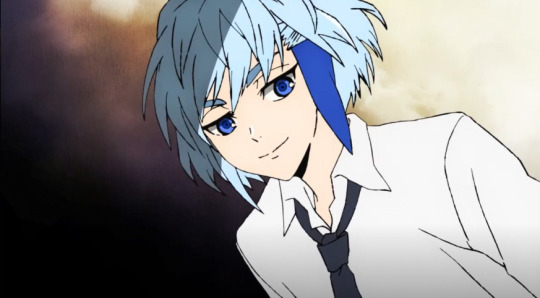




-The two hot boys have shown up. Interesting they’re both under honor and pride, since the two hate each other’s guts. Hatz strives to bring honor as swordsman and places a lot of his pride into that. Meanwhile, Khun strives to regain his honor taken away from him after his exile, and his overwhelming pride causes problems for him.
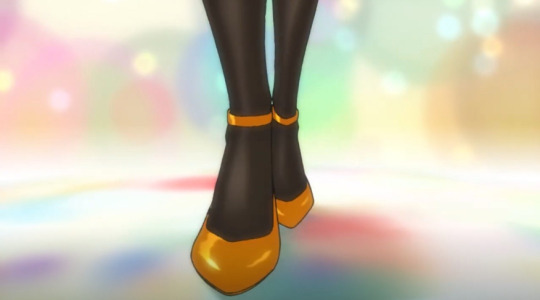

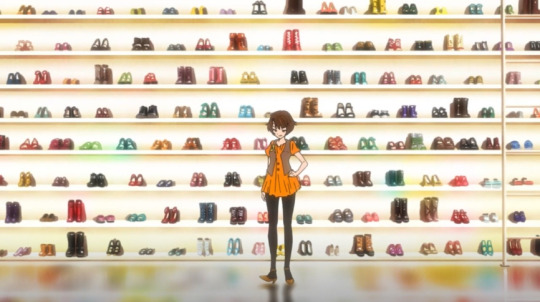
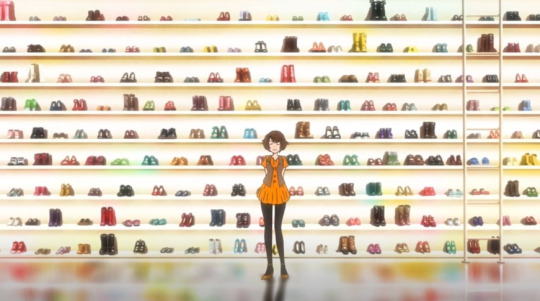
-In this small scene, there’s so much symbolism about Endorsi’s character. First, we focus on her shoes, which links to the idea of how Jahad’s Princesses are called the shoes in the king’s showcase. Right now, she is a shoe, walking towards her destiny of entering the tower. Then we get a shot of her face, a mix of adorable and pretty. These two shots indicate what everyone sees when they first meet Endorsi, a princess and then just a pretty face. Until it finally pulls back and shows the many other shoes in the showcase, to which Endorsi is compared to and what people hope she becomes. However, she stands outside the case because she wants freedom from her duties as a princess.
-Another interesting thing about the showcase shot is that while Endorsi is at first front and center, she’s ultimately dwarfed by the many other shoes that come into frame, showing that even if she’s a princess, she’s just one of many and can easily be made (replaced) again.
-The power and influence line shows Endorsi wants. She wanted power to become stronger than the other girls at her home, and eventually she gained it. Now she wants power to become a popular princess, which will give her influence. With her influence she might be able to change something about the princess system, just like what Yuri wants.
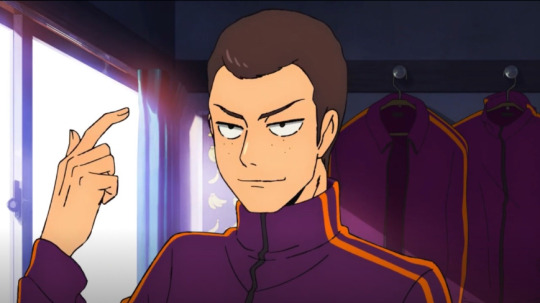
-Shibisu is under the money and wealth, replacing Narae. Now, we don’t actually know Shibisu’s backstory. We’ve gotten hints of it such as someone taking something from him, but we don’t know the full story. Might this give a clue into his past?

-Anaak is probably the most easiest to explain. She wants revenge on the Jahad family for her mother and father’s deaths. However she eventually mellows out with this, preferring to keep her teammates safe then strive for revenge (like in the Name Hunt Station Arc)

-Rak wants to transcend all. Basically become stronger than anyone, and he’ll gain this power by hunting down strong prey and proving he’s stronger.


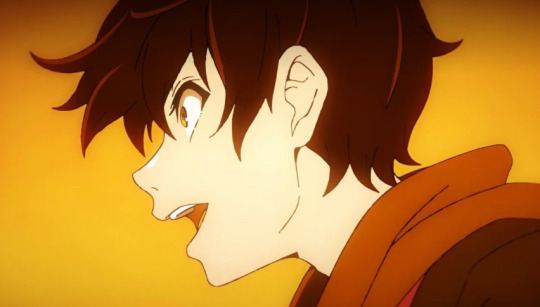
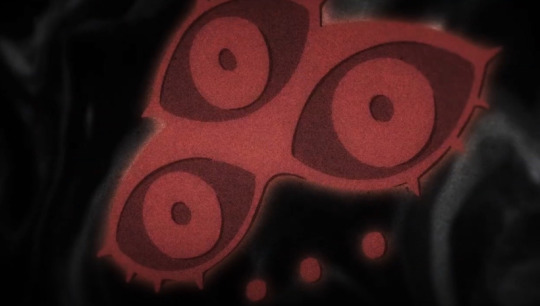
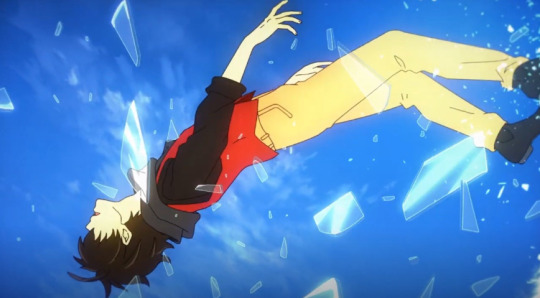

-I can’t really do an analysis of the op cause most of it is just Bam walking and stuff, so here are my fav shots (Though the yellow one scares me). Interesting that we get a shot of the Jahad symbol in the op, though it makes sense with just how important it is. Though I don’t know what was up with the bird. I guess it’s meant to represent freedom, but ToG is more full of water metaphors than sky. (Also the only time birds are relevant in ToG is when they appear and then die)
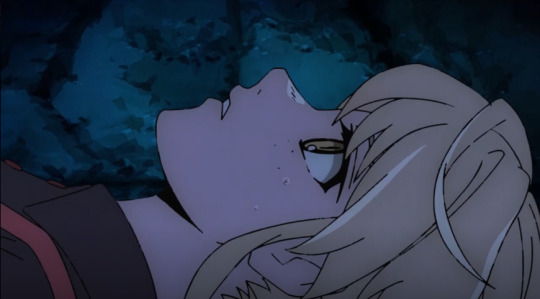
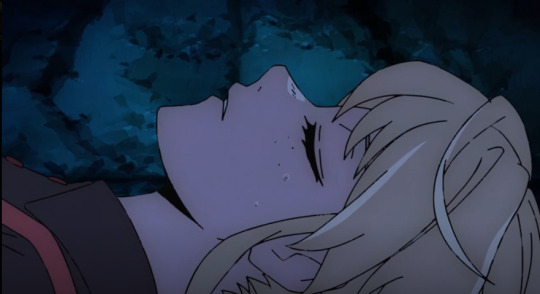
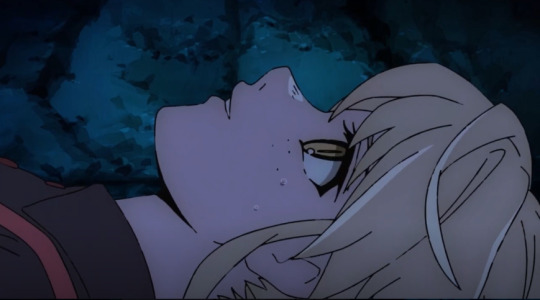
-I love Rachel’s little smile after Bam tells her he doesn’t want her to go up the tower. It seems like she’s smiling to calm him down and explain the situation, however you can also see the fakeness in it. She isn’t smiling because she feels bad for Bam, she’s smiling because she feels like she has to.

-This shot still confuses me. It’s like the tower itself is vibe checking Bam.
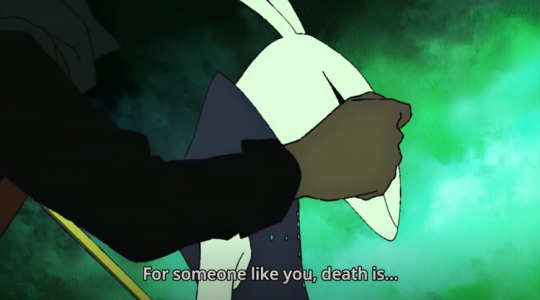

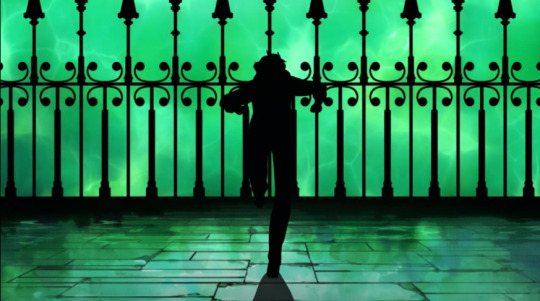
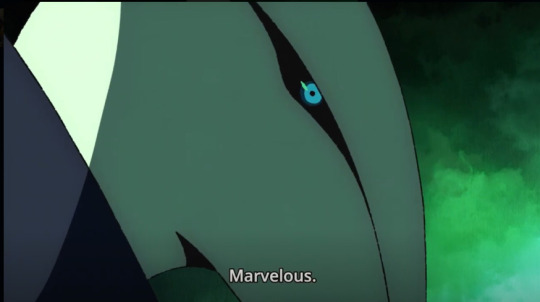
-Subarashi
-Bam subscribes to the “No Waifu, No Laifu” train of thought. And just as I predicted, people are already calling him a simp. I guess I can let it pass for now, but’s gonna get annoying if people keep calling him that, even after S1.


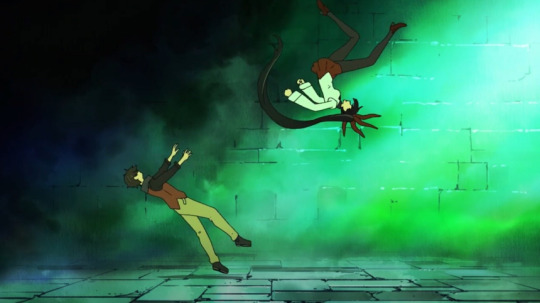
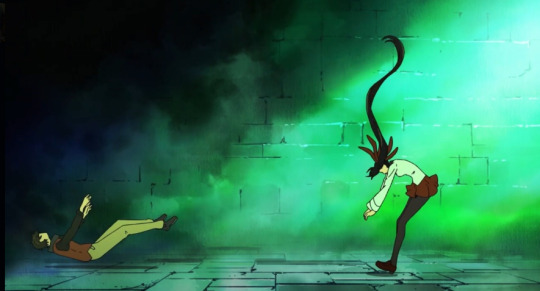

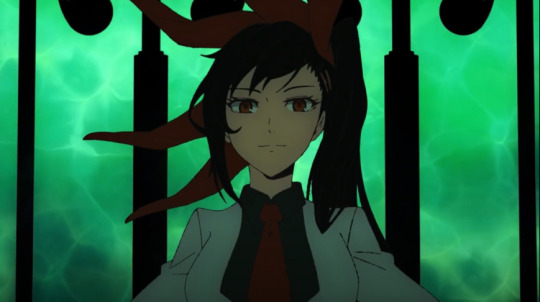
-Thus, the meeting that forever changed the tower’s fate has occurred. And it all started with a kick to the face.
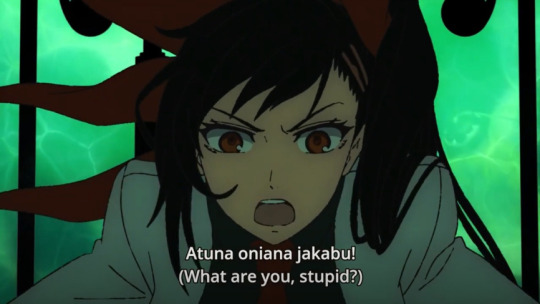

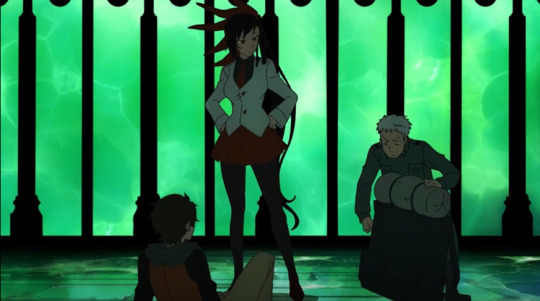
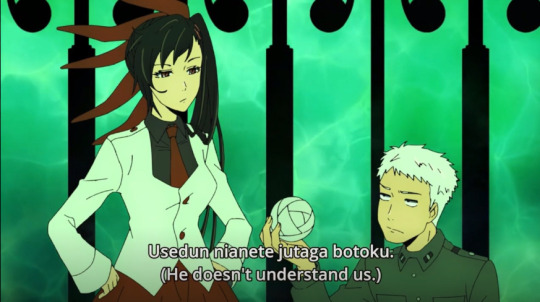
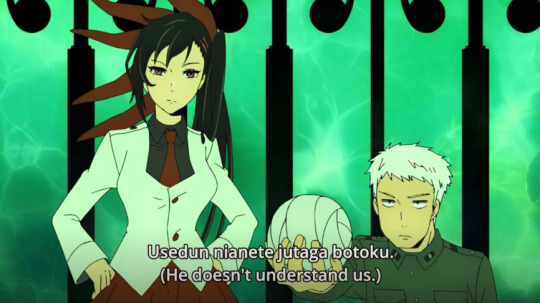
-Seeing Yuri and Evan together makes me happy. They’re such a great duo that feel better together than split. Also I’m interested in the language they’re using. Is it a real world language, fake, or a mix of a few languages? Either way, it seems that Yuri and Evan might be able to understand each other without a Pocket (maybe because Evan’s guide abilities allow him to know every language in the tower?)

-Gotta say, the CGI looks very crappy, especially in mix with the extremely cartoony style of ToG. Hope we don’t get to much of it.

-Why are they saying Non-Regular. It’s supposed to be Irregular. The trailers got it right, so why is this different?

-Love how Bam’s the only one who reacts to the threat of execution. Evan and Yuri probably hear that on a daily basis so it doesn’t matter as much.

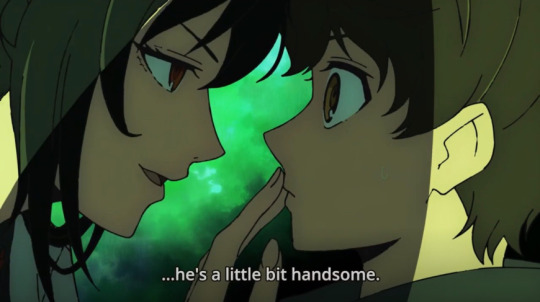
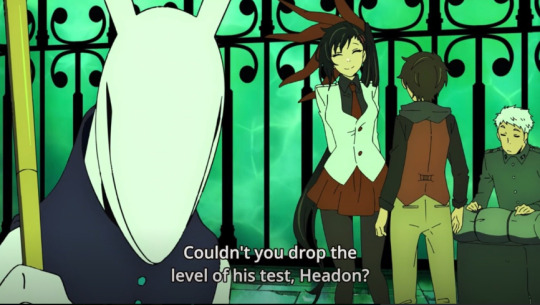
-Yuri went from shitting on him to wanting to fuck him in a second. Normally I’d criticize such a thing but since Yuri has a different agenda, and the circumstances between princesses and men, I can’t blame her for wanting a handsome man to go up. (Seriously all the princesses must be sexually frustrated)
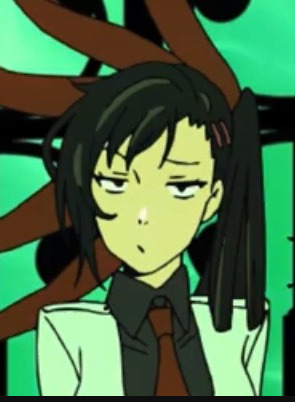
-Anaak’s my favorite girl in S1, but I think Yuri’s gonna convert me if she has more of these great faces.

-Another translation error, but one also translated wrongly in Japanese. It’s supposed to be needle, but they say katana (sword in japanese). If I’m remembering correctly, only one 13 Month Weapon is actually a sword.
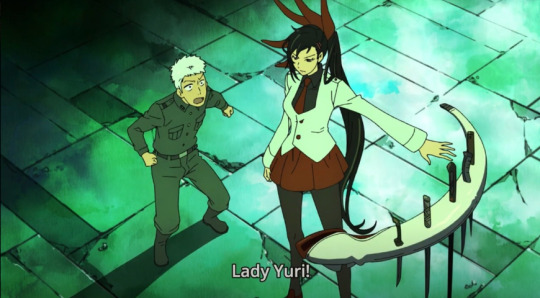


-Poor Evan. Then again, even if it seems he has a weak hold on her, he’s probably the best one for the job. Since he’s one of the highest ranking guides, he’s probably stuck taking care of either hard to handle or strong princesses.

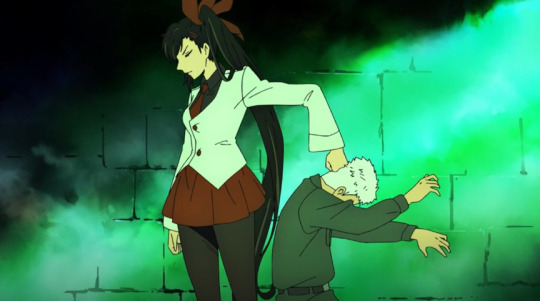

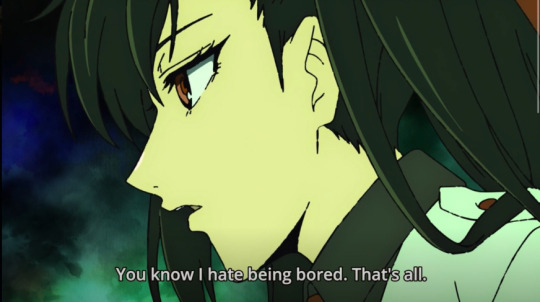
-Their relationship is adorable. I have a thing for tall girl x short boy and this fulfills it all the way. Also, Yuri saying she hates being bored is really telling of just how much of an adventurous spirit she has. Even in the tower where things are hectic all the time and she works under Jahad and Wingtree, she still desires a world outside of the norm. I wonder if meeting Phantaminum really broadened her horizons that much?
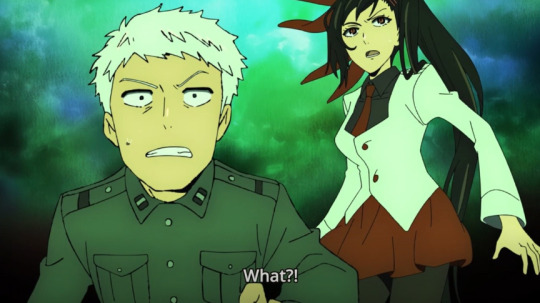
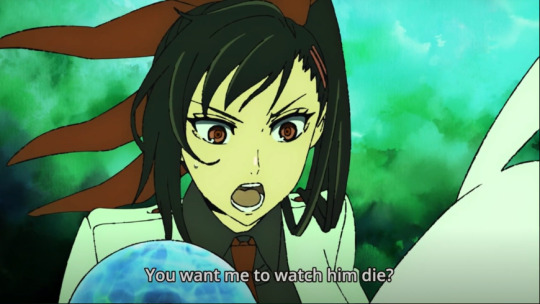
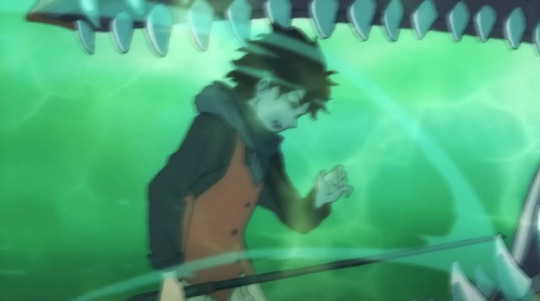
-Love seeing all the buildup just to get to Bam being eaten. It’s a great way to subvert expectations from him just cutting it normally. Also in the manwha, Yuri says the needle is for stabs and pierces, probably giving Bam the idea of entering the eel.
-Also Yuri for best big sister in anime pls.
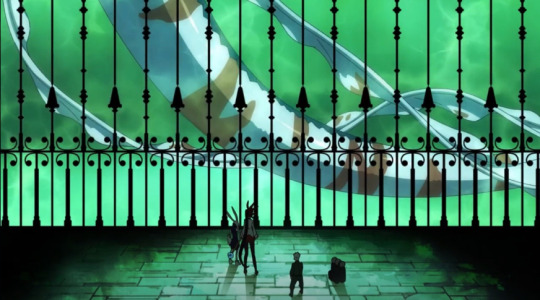
-”Welp, let’s go home”
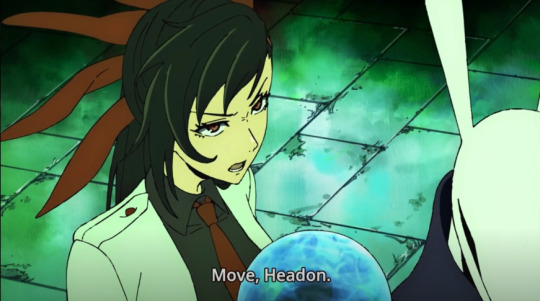
-Yuri was about to try and punt an administrator. How can she walk in such dense shinsu with balls as heavy as hers
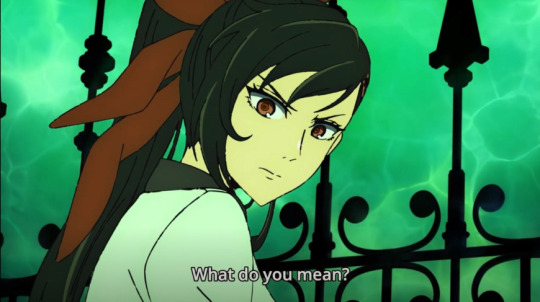
-Can we talk about the amount of trust in Yuri and Evan’s relationship. Sure, Yuri protested when grabbed by Evan, but when she heard that Bam had taken the right path she immediately stopped fighting or rushing to break in there. Even if she couldn’t figure out what the path was supposed to be, she believed in Evan’s words that Bam had done it right and stopped fighting.
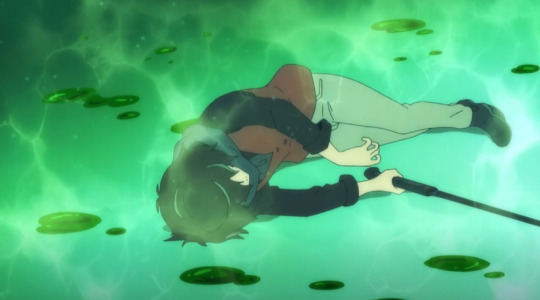
-Bam’s gonna need a bath


-I love these two shots. Just the raw determination Bam has is inspiring. We should all be like Bam, except maybe focus that determination into a hobby or work instead of stalking a girl.

-Yuri about to punt Headon part 2




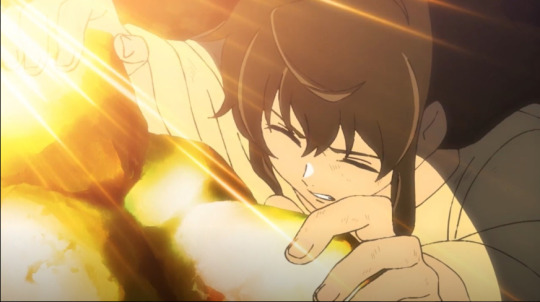
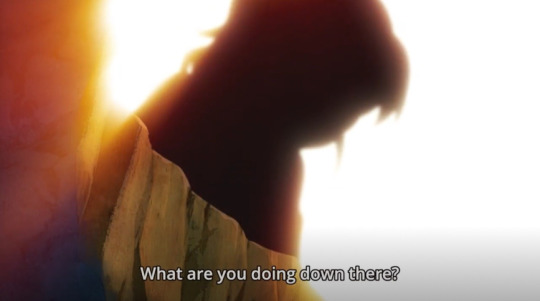




-This scene had me tearing up. No matter how horribly the two’s relationship progresses in the future, this scene will always be sweet because it’s the two’s raw, positive emotion. Bam was stuck down there for weeks, months, maybe even years, and finally someone comes along and says they’ll be there with him. Even if he didn’t leave the cave, his world got brighter just by having Rachel there. I’m glad they included this scene because it shows why Bam is so desperate to get Rachel back, to get his light back.
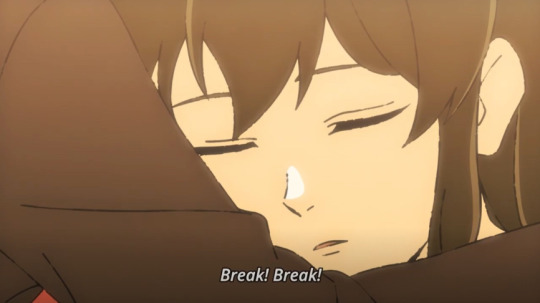
-This is precious


-I can’t believe I’m actually saying this but Rachel looks adorable

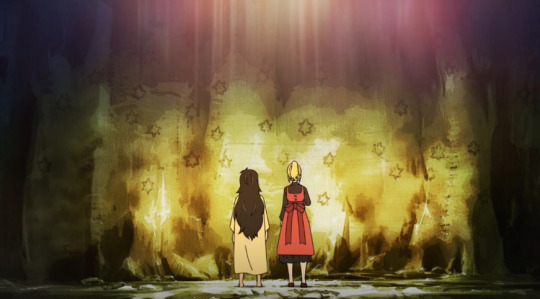
-These shots are so simple yet so powerful. If only they could have stayed like this

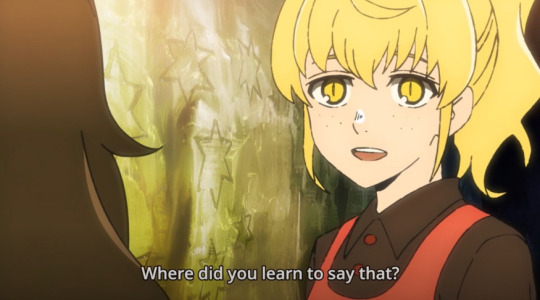

-Bam is smooth. This dude spent years in a dark hole with no one to talk to and yet he can still pick up girls. Also I think this scene shows that Bam and Rachel have more of a sibling relationship. Ruffling his hair is more of a big sister type of thing.


-Based on Yuri’s reaction, this is probably the most determined she’s seen Evan



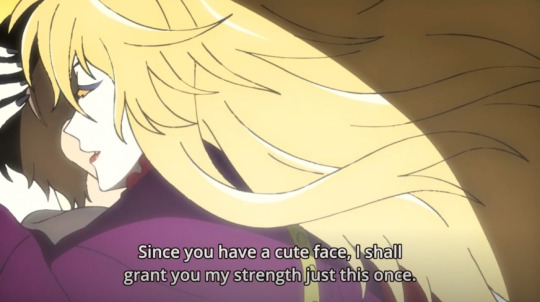
-Black March is top tier waifu material even though she’s just a needle. I like that the animators made her look more mature. It shows that she’s an old weapon without needing to say it.
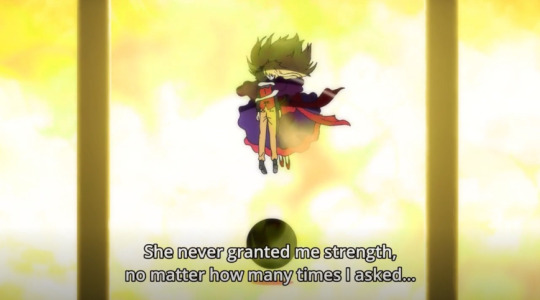
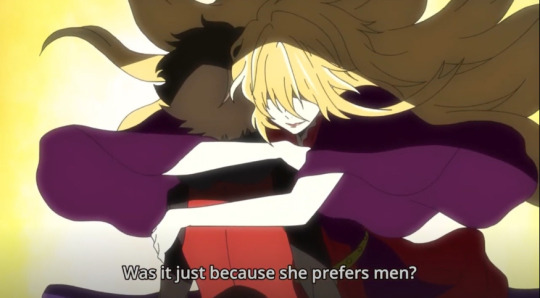
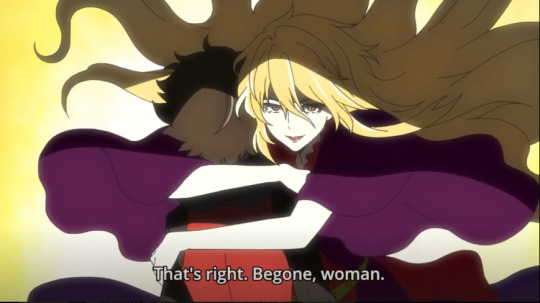
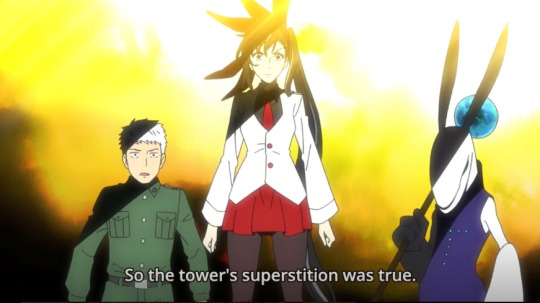
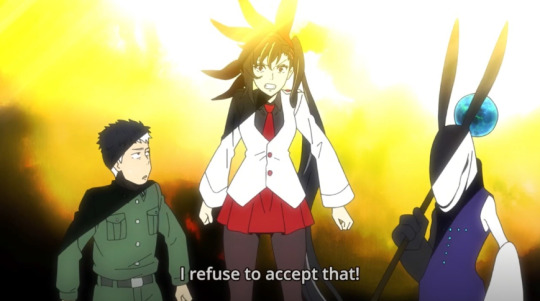
-BEGONE THOT
-I love how Black March’s preference in men was a superstition. Also can we talk about Evan’s face in the last panel? It’s beautiful.

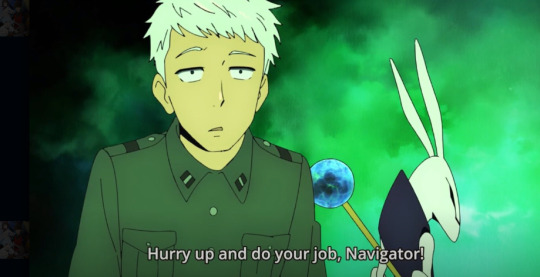
-Honestly, it’s hard to tell who’s in charge of who

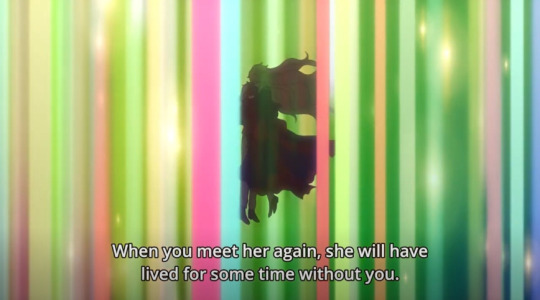

-That feeling when a sexy, needle lady will never hold you in her arms, why even live?

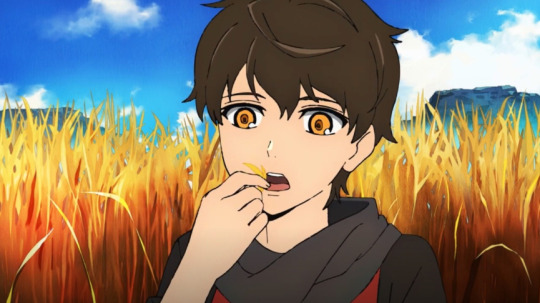

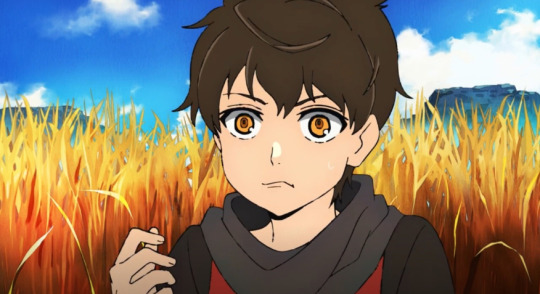
-I love how Bam’s first reaction to entering a new place was to eat it’s grass. Bless this precious child

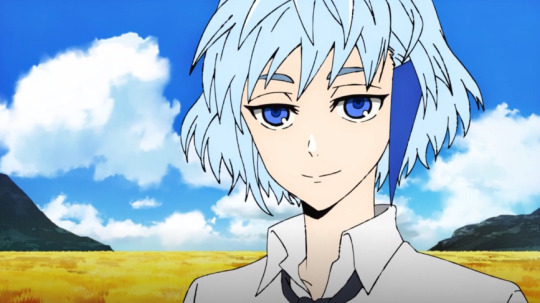


-And finally, it ends off with the RaKhunBam trio. I’m so happy to see all three of them together.
This episode had it’s good points and it’s bad points but either way I’m excited for the rest of this journey, especially seeing the anime onlys reactions.
109 notes
·
View notes
Text
Mesquite: The Tree of Life of the South West

"I could ask for no better monument over my grave than a good mesquite tree, its roots down deep like those of peace who belong to the soil, its hardy branches, leaves, and fruit holding memories of the soil..." J. Frank Dobie, Texas Writer
Overview
The name mesquite derives from the Hispansized word 'mizquitl'.
There are more than 40 species of mesquite trees found worldwide, at least 90 percent of which grow in Latin America, principally Argentina and Chile. Although mesquite also thrives in other arid regions such as those in Southwest North America, Africa, the Middle East, Tunisia, Algeria, India, Pakistan, Afghanistan, Burma, Hawaii, West Indies, Russia, Puerto Rico, and Australia.
The tree itself comes in a variety of sizes depending on rain fall. Locations with higher rain fall note mesquite trees ranging from 40-50ft in height with a spread of nearly 40 feet or more. The branches are sparsely covered in thin feathery leaves with 2inch thorns growing at the base of the leaf joints.
This blog will mostly focus on Latin America; specifically in the Southwest Us and Texas.
There are seven varieties that cover one-third of the state of Texas or 56 million of the 167.5 million acres of land from the Rio Grande to the Panhandle, across central and north Texas and into much of west texas. Of all the US states 76 percent of mesquite wood grows in Texas. Mesquite grows in all regions of the state except the deep East Piney Woods.
Out of the seven varieties, the post will mostly reference Prosopis glandulosa var. glandulosa a.k.a "Honey Mesquite".

Map of the American South West and Latin america showing the range of Mesquite tree growth.
Native Tribes: Resource and Myth

Description reads: Salt River Reservation, Pima Agency Arizona, two Maricopa men(sitting) and Mojave Man in full aboriginal dress. 1880
Mesquite was such an omnipresent and nutritious resource and a central part of life itself that many tribes such as the Walapai, Apache, Papago, and Maricopa honored mesquite within their language and mythology.
Mesquite beans were the food staples for many of the South West Native American tribes. Through out the United states they gathered millions of pounds annually. In cases of food shortages, mesquite beans were often the only food source.
Much of the plant material such as fiber, thorns, sap, and roots were used in the making of many goods. The fibers were used for making of textiles and baskets. The
The creation myth of the Maricopa states that the Maricopa, Pima, and Yavapai -after death of their maker- scattered over the land and gathered mesquite beans. An Apache myth recounts how the sun and moon consulted with one another and formed the mesquite tree then hung beans upon its branches. The death of the Coyote myth of the Pima tells of Mesquite surviving the Great Flood and of how the coyote ate so many beans that they swelled in his stomach.
The Mesquite was an extremely important resource and was used frequently as an amenity of trade between the Apache tribe and the Pima tribe. When food plants failed during time of drought the Pima would travel long expeditions to trade goods with the Apache for beans and bean flour. With it, the Pima made dough and cooked it as round cakes. Certain tribes such as Pima and Opata also fermented bean flour water creating a bean beer called Atole and has a mildly intoxicating quality.
The gum, or sap, of the tree was used as adhesive to mend broken pottery as well as dye clay before the heating process. The gum when mixed with mud was used in several tribes spiritual and courtship rituals.
Both leaves and gum of the Mesquite is known by the tribes to carry healing powers and medicinal properties.
The Yaqui community in particular honor mesquite as one of two plants to have supernatural powers beyond most other plants. However of the two, only Mesquite grows in the sacred territory of the Yaqui and is said to have powers to detect and vanquish witchcraft especially if the wood is cut into a shape of a cross. One Yaqui myth tells of a "talking stick" made from mesquite wood which foretold death to all people baptized as christian.
Anglo-Texan History
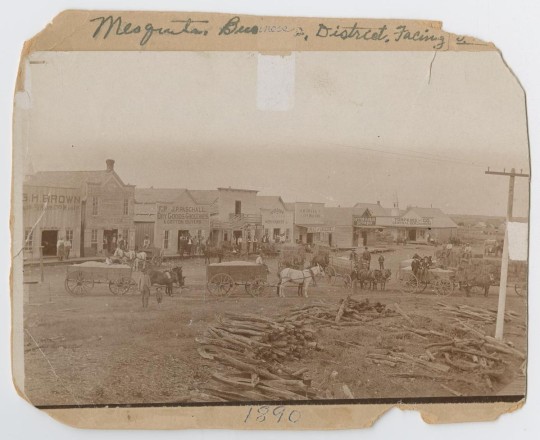
Image of Mesquite Texas, 1890 showing piles of mesquite branches and horse drawn wagons containing grain or beans.
Historians believed that the mesquite was orginally limited to extreme South Texas and spread north only after the Civil War when cattle drives became frequent. Cattle would eat mesquite beans when grass was not plentiful.
Early Texas settlers facored the mesquite wood because not only was it plentiful but it also resisted rotting. Before commercial barbed wire came to texas in the 1870s, ranchers built sturdy corrals from mesquite-log picket fences. Travelers also fashioned hubs for wagons, wagon spokes, and small boat ribs from mesquite.
During the civil war, when coffee was scarce, Texans made ersatz coffee from roasted and ground mesquite beans. Honey made from mesquite flowers was especially prized. In the absence of pins, settlers substituted mesquite thorns.
In the 1869 Dr. John E. Park of Sequin patented under the no. 51,407 on December 5 for the use of mesquite bark in tanning leather. In the article from 1870 Texas Almanac, he included information on the superiority of the use of Mesquite in tanning leather. For, mesquite was found to be richest in Tannic Acid (a substance used for tanning) and worked exceptionally faster than previous methods because the acid penetrated the hide faster. Fast enough to seldom lose hide to decomposition. This allowed for tanning to be done in summer months, a process usually done in winter.
Medicinal Uses
*Note: not a replacement for modern day regulated medications and treatments.*
Aztecs made a lotion from ground mesquite leaves to treat sore eyes.
The Yuma tribe treated venereal diseases with an infusion of leaves and sap.
Comanches chewed on leaves to relieve toothaches.
The Yaqui Tribe treated headaches with a poultice made from mashing leaves to a pulp, mixing with water, and binding the mixture to the forehead.
The light-amber gum or sap that oozed from mesauite bark was mixed with water and gargled to treat sore throats, or swallowed to treat diarrhea, aid in digestion, and help wounds heal.
The Yavapai rubbed a mixture of mud and mesquite gum into their hair to simultaneously dye it and treat lice.
Modern Uses
Although ranchers still try to annihilate mesquite due to injury of livestock and cowhands, a dedicated group of texans cant get enough of it. They are mostly artisans who value mesquite for its beauty, the ease with which it can be worked, and the high sheen of finished pieces. Some even prize its irregularities.
Mesquite has a swirling grain, radial cracks, mineral deposits in the bark, and often many insect holes. Mesquite is dimensionally stable: as most hardwoods dry they shrink more in one direction than they do the other while mesquite shrinks the same percentage in both directions. It has a surface hardness of 2,336 pounds per squared inch, equal to that of hickory and almost twice that of oak and maple; and a density of 45 pounds per foot greater than oak, maple, pecan, and hickory.
Modern Spiritual interpertations:
Harmonizing qualities
Accessing the willingness to cross the wasteland of "dark night of the soul" to find deep spiritual richness within yourself and others
Comfortably connecting with others from a place of compassion and warmth
Standing inside a circle of love
Self blessing
Forgiveness
Possible use for Mesquite in imbalances
Emotional remoteness
Aloofness
Allowing others to see a coolness that actually covers an inner warmth
Feeling as is there is a barren wasteland or spiritual desolation within self.
Feeling separated and remote from others or self.
Personal Suggestion on craft Use*
*Disclaimer: subject to error and not a replacement for actual medications; allergy notice: mesquite is part of the legume family. Research trees and plants in area before ingesting random plants. Watch out for use of pesticides in public places. I do Not recommend diy fermentation. I do not support appropriating native tribes' traditions and rites unless explicitly permitted to by said tribe, do NOT trespass on Sacred Lands for resources it may be possible to purchase sacred mesquite from the tribes. Do Not vandalize sacred grounds or public trees. BE RESPECTFUL.*
Mesquite is tasty. Use wood for rich Smokey flavor on barbequed meats and vegtables.
Make tea from leaves
The beans are said to taste sweet and contain 30 percent sugar trace. Eat beans raw, roasted, dried, or ground into a flour.
Use water diluted sap to treat rashes. (Unless allergic.)
Use diluted sap in hair as you would oils.
Burn leaves and wood to smoke cleanse.
Hang mesquite cross to avert hexes or harmful craft.
I recommend buying from South Western Tribes and other mesquite artisans for bobbles and other wooden figures. Otherwise, source your mesquite in an earth friendly manner by sustainable means and only take what you need.
Information Sources:
"The Magnificent Mesquite" book by Ken E. Rogers
Texasalmanac.com
Desert-alchemy.com
Local Texans
Picture Sources: Google and pinterest
#mesquite#witchcraft#witchy#witch#witches#greenwitch#green craft#green magick#green witch#mesquite tree#native american#tribes#southwest#south west united states#texas#wood crafts#wood magic#wood carving#woodworking#mesquite history#history#leather#leather working#cooking#educational#desert witch#desert craft#desert#trees#almanac
165 notes
·
View notes
Text
Assignment Week 1
Data Management and Visualization
WEEK 1
ASSIGNMENT: Developing a Research Question and Creating Your Personal Code Book
STEP 1: Choose a data set that you would like to work with.
After reviewing the code books for the data sets made available for this assignment, I choose code books for the data set of National Longitudinal Study of Adolescent Health.
STEP 2: Identify a specific topic of interest.
After run through the codebook for the National Longitudinal Study of Adolescent Health, I have decided that I am particularly interested in the factors that influence the adolescents’ health in the United States. From the data given in the codebook, I would like to analyze more on the one factor; does daily activities influence the general health of the adolescents.
STEP 3: Prepare a codebook of your own (i.e., print individual pages or copy screen and paste into a new document) from the larger codebook that includes the questions/items/variables that measure your selected topics.)
Factors influence Adolescents General Health Codebook
a) Topic of interest: Adolescents General Health
b) Variables : Daily activities













STEP 4: Identify a second topic that you would like to explore in terms of its association with your original topic.
The second topic that I intend to explore that associate with the original topic is the correlation between uses of social media with adolescents’ general health.
STEP 5: Add questions/items/variables documenting this second topic to your personal codebook.
Some questions/items/variables that can be ask during survey:
1. Do you use social media?
2. How many hours a day do you use social media?
3. Which social media platform do you use most often?
4. How influential is social media in your life?
5. Do you using any social media platform to promote a healthy lifestyle?
STEP 6: Perform a literature review to see what research has been previously done on this topic.
Social media play an important role in the daily lives of young people and have become important contexts for development among adolescents and young adults 1. Early adolescence represents a period of vast developmental changes that span across the physical, psychological, and social dimensions of an individual 2. Extant developmental research suggests that adolescents and young adults use social media for self-presentation and self-disclosure, and these behaviors are linked to their identity and intimacy development and well-being 3.
Undeniably, engaging in various forms of social media is a routine activity that research has shown to benefit adolescents by enhancing communication, social connection, and even technical skills 4. According to research conducted on 2011, 22% of teenagers log on to their favorite social media site more than 10 times a day, and more than half of adolescents log on to a social media site more than once a day. Seventy-five percent of teenagers now own cell phones, and 25% use them for social media, 54% use them for texting, and 24% use them for instant messaging 4. However, these days a large part of this generation’s social and emotional development is occurring while on the Internet and on cell phones. Because of their limited capacity for self-regulation and susceptibility to peer pressure, adolescents are at some risk as they navigate and experiment with social media. Recent research indicates that there are frequent online expressions of offline behaviors, such as bullying, clique-forming, and sexual experimentation, that have introduced problems such as cyberbullying, privacy issues, and sexting. Other problems that merit awareness include declining health, internet addiction and concurrent sleep deprivation.
Evidence is increasingly supporting a link between social media use and various aspects of adolescent wellbeing, especially general health including sleep quality and mental wellness 5. Poor sleep quality is prevalent in adolescents and is known to contribute to depression, anxiety and low self-esteem. Besides that, sleep deprivation also could lead to other major health issues such as heart disease, irregular heartbeat, high blood pressure, stroke, and diabetes. Furthermore, an association between poor sleep quality and overall social media use would support the role of a less physically active lifestyle. Excessive time spend on social media among adolescence lead to sedentary lifestyle which contribute to much more health issues. Previous findings on Internet use in general are certainly relevant when considering social media use specifically, as young people spend 54% of their time online using social media 6.
Adolescents’ use of social media, which has increased considerably in the past decade, has both positive and negative influences on adolescents’ health. As social media is the most prominent communication tool of choice for adolescents, it is important to understand the relationship between the frequency of social media use and health behaviors among this population 7. Regular social media use every day was associated with a reinforcement of health behaviors at both extremes of health behaviors, whereas a medium intensity of social media use was associated with the highest levels of physical activity and lowest sleep adequacy among those with moderate health behaviors 7. Hence, finding an optimal level of social media use that is beneficial to a variety of health behaviors would be most beneficial to adolescents who are in the middle of the health behavior spectrum.
References:
1. Michikyan, M., & Suárez-Orozco, C. (2016). Adolescent media and social media use: implications for development.
2. Salomon, I., & Brown, C. S. (2019). The selfie generation: Examining the relationship between social media use and early adolescent body image. The Journal of Early Adolescence, 39(4), 539-560.
3. Bartsch, M., & Subrahmanyam, K. (2015). Technology and self-presentation. In L. D. Rosen, N. A. Cheever, & L. M. Carrier (Eds.), The Wiley handbook of psychology, technology, and society (pp. 339-357). Chichester, UK: John Wiley & Sons, Ltd.
4. Fernández, A. (2011). Clinical Report: The impact of social media on children, adolescents and families. Archivos de Pediatría del Uruguay, 82(1), 31-32.
5. Woods, H. C., & Scott, H. (2016). # Sleepyteens: Social media use in adolescence is associated with poor sleep quality, anxiety, depression and low self-esteem. Journal of adolescence, 51, 41-49.
6. Thompson, S. H., & Lougheed, E. (2012). Frazzled by Facebook? An exploratory study of gender differences in social network communication among undergraduate men and women. College Student Journal, 46(1), 88e98.
7. Shimoga, S. V., Erlyana, E., & Rebello, V. (2019). Associations of social media use with physical activity and sleep adequacy among adolescents: Cross-sectional survey. Journal of medical Internet research, 21(6), e14290.
STEP 7: Based on your literature review, develop a hypothesis about what you believe the association might be between these topics. Be sure to integrate the specific variables you selected into the hypothesis.
Based on the literature review, we can suggest a hypothesis that greater overall social media use will be associated with poorer general health among adolescents.
1 note
·
View note
Text
The Doctor Told How Much Sex A Week Is Needed For Health
Doctor-sexologist Yevgeniy Kravchuk said that two or three times of intimate contact a week is enough to maintain health, Sputnik radio reports. Check out here for more details about sex.

The expert noted that in modern culture, sexual motives are extremely common, so a person begins to think that something is going wrong in his life. To get rid of such anxiety permanently, it is better to see a doctor. If such a desire does not arise, then Kravchuk advises to follow the "sexual norm".
The doctor explained that the concept of UVR is important for sexology - a conditionally physical rhythm. This indicator is not strict. But it is generally accepted that, according to the UFR, a person needs two or three intercourses a week. Kravchuk stressed that this is an average indicator, but one cannot ignore the temperament and needs of each person. If a person does not get his norm, then his quality of life is worse and his health is worse, ”added the sexologist.
Exceeding the norm of sexual activity also negatively affects the general condition of a person and his health, including mental. Intimate contact can get bored if it is much more than necessary. In addition, there are specific cases when it should be abandoned. For example, on the eve of important events, it is better to abstain from sex at least a day before. The doctor explained that after intimacy, the nervous system needs rest - it goes into a "protective" mode. If the event requires high results, then they will definitely be lower. Therefore, you should refrain from sex before the event, but make up for everything after, emphasizes Kravchuk.
Work also affects sex , experts say. An accomplished person who has found himself in his business, seeks to be realized in the intimate sphere. Representatives of creative professions, as a rule, also have high life potential, including sexual potential.
Female sex hormones have a stronger effect on the immune system than male ones. Therefore, women are more likely to suffer from immunodeficiency than men, especially if they have menstrual irregularities. But the hormone of happiness serotonin, which is produced after sex and not only, acts equally well on the immunity of both sexes, explains obstetrician-gynecologist Evgenia Pekareva.
If the need for intimate relationships is naturally great, then the lack of sexual life will negatively affect the emotional state, thus reducing the quality of a woman's life. However, an orgasm experienced with a partner is not very different from an orgasm experienced on its own, so masturbation is a good way out of the situation, says obstetrician-gynecologist Evgenia Pekareva.
More often it is more like "but I heard." Ask any doctor about the causes of any of the diseases, he will list them for you a dozen or two. Perhaps the absence of sexual intercourse will also be listed among them, but it is impossible to establish that this was the decisive factor. Take the same problems in the genitourinary sphere in men and women, which have become quite common in our time. And at the same time, a more significant factor for maintaining health in this area is the issues of maintaining a healthy lifestyle, regular exercise, absence of bad habits, adherence to the rules of intimate hygiene and sexual safety, periodic visits to the doctor and passing all the necessary tests for STDs, the expert believes.
1 note
·
View note
Text
What I Tell Older Parents

Streams of “Living Waters” … it’s why I am writing; it’s what I have been trying to share as I work my way through Frances Jensen’s, “The Teenage Brain: a Neuroscientist’s Survival Guide (yada yada yada). Jensen makes the observation that there is an overabundance of myths regarding the brain and how it functions within our popular society and even in medicine -- e.g. that teenager behavior is reducible to “raging hormones,” or that “multi-tasking” is even a valid notion (hint, it’s entirely not, we just task-switch really fast, but with great limits). There is great freedom which I am finding through the rigorous application of science, allowing science to inform my faith and my understanding of these years enough to lay down burdensome and wrongheaded expectations on myself (as a parent) -- expectations which don’t align with the reality of this developmental period.
As I have written in other posts, the teenage brain is only about 80 percent developed, and still wiring in the area (the Frontal Lobe) which is responsible for judgement, insight, abstraction, planning, and impulse control. Thus it is that the wild responses, the outbursts and emotional mood swings are understandable in light of this ongoing development, and are something for which the teenagers themselves have very little control over (and why parents have all the nore reason and all the more excuse to be patient and compassionate with thier teens). It is also a time, this period of adolescence, when experiences are imprinted upon and learning is supercharged, and thusly why their being exposed to new experiences repeatedly is so important (and also not only why the teenage years are the years in which to be investing more fully in mere schooling-unto-career alone, but the years in which the parent can join and participate in the wonder and excitement of it all). These years are to me as good and as wondrous and as adventurous (for these and other reasons) as were the infant years. It goes without saying (though I said it) these years and the development within them behooves the parent to mercifully stay the course (especially the course of patience and compassion, not “frustrating” their children, that is, not throwing up unrealistic expectations which essentially are developmentally inappropriate).
Maybe the most quickening, the most “attention-grabbing” insight (for me) is that the imprinted upon experiences during the adolescent period plays a role later on in life, and in how the brain works later in life. To get straight to the nut of this tree, these adolescent years arguably are our most effective years as parents, but are also extremely vulnerable years for our children. Now, a personal aside, I vaguely remember two quotes (one from Mark Twain, and one from a disgraced comedian not to be named but who worked on an advanced degree in child development), both of which went generally along the lines that, as children they thought their fathers superheroes, as teenagers thought their fathers idiots, and as mature men thought their fathers geniuses. I talk to a lot of older, Christian parents, many of whom bemoan the difficulty of the teenage years and remark how their children seemed after high school to have gone off the rails. I simply tell them that they loved on their children with the love of God, and that love is the Word of God which does not go forth and return void but accomplishes the purposes for which it was sent. Some actually seem to receive that, go figure. The bottomline is that in these teen and adolescent years we are affecting how they will be and think in the future (regardless of the present moments’ incongruous irregularities with then and now).
The more I read in Jensen’s book the more I think I might just be right in what I have told them on a whole other level. And, like I said, the quickening thing is how important and how vulnerable these years are. The teenage brain is just different, absolutely different, in how it functions, and if we want to parent well we have to parent according to how that teenage brain functions -- the importance and the vulnerability of these years demand we do no less. And this means learning the science of the brain. Critically, and Jensen specifically makes this point, no two brains (and no two teenage brains) are wired the same way at all. One I think should surmise that you not only have to deal with them, teenagers, as unique and seperate individuals (just as you had to when they were young), but that you have to deal them as they neurologically function as teenagers.
To illustrate this point: in discussing how the vulnerability of the adolescent brain continues well into the college years, Jensen relates the story of a college kid who had gone out drinking with friends, and the friends subsequently decided to climb a fence to get into a secured tennis club’s pool for a late night swim. When the friends got home they realized they were missing the young man from their number, returned to the club only to find the friend dead, accidentally drowned due to “acute alcohol intoxication.” Jensen emphatically states that how parents deal with these tragic stories and talk about them with their own children is critical:
“You have to stuff their minds with real stories, real consequences, and then you have to do it again…” {She goes on to list a litany of times to take the opportunity to do so.}
Later Jensen explains that one of the frontal lobes executive functions includes “prospective memory” ( “the ability to hold in your mind the intention to perform a certain action at a future time”), but during the teenage years this part of the brain simply isn’t keeping up with the rest of teenage development. For this reason, even though they have heard it a 100 times before, teenagers need to hear it again. Of course just harping on things (things not to do) is not the way, is not the right methodology for “stuffing their minds.” To be sure, this “methodology” has been the subject of so many articles I’ve read of late, and all seem to amount to how to (and how not to) engage through dialogue, and dialogue (as we well know from our own lives) takes work and time and effort.
I really REALLY WANT TO UNDERSCORE the above quote that we are stuffing the mind with “real stories of real consequences” if only because that gives me what i need to latch on to what I am talking to my teenagers about. I can talk about stories, about consequences, WITHOUT READING A CHRISTIAN BOOK on how to moralize these things to my children -- that latter effort is the onerous, burdensome “have to figure out” thing that sort of misses the point: what I am supposed to be doing is equipping my teenager with the ability to remember, the bolstering of their prospective memory ability (and doing so maybe, IMHO, to the expense of moralizing). Said slightly differently, telling my kid 100 times that premarital sex is wrong is less effective than dialoguing about how to identify those moments and heightened emotional states when decisions are made which lead to real consequences. The only thing moralizing does is effectively breed guilt and condemnation when that child, unequippedly, faces the situation I wrongly expected them to be neurologically be capable of handling like the adult they aren’t. HINT HINT: I might bear as much “fault” or more than my teenager in that moment.
Like I said, this is a time for effective parenting, but it’s essentially a parenting predicated on learning and responding to the teenage brain for where it is at.
0 notes
Text
They socialize in later

Senior high school trainee falls under a fantasy globe!
I am rather bad tester and viewers, however I truly feel that I need to talk about this manga. I need to protect my manga because this mangabat is among my most favorite mangas. As well as I hope you enjoy it as I did. This publication is about a mean high-schooler who's above? Common in archery. 1 day he's thrown into a location utilizing Moon-Bro, has actually been carried from the Bug in the price that she would certainly take among his children and where stated MoonGod-Bro makes clear that his parents are from one more world. Our major personality requires to be carried additionally requires the duty in place, leaving letters to obtain his family. After he arrives him tosses into the boundary of the planet for not being 'relatively'. MoonGod-Bro saves him and also defines him that individuals possess extremely power within this world and provides him a few of his very own abilities in the area of the Bug's "true blessing". Providing so we won't see him once again.
That's essentially it, the remainder follows his journeys in this new universe. It is till these crap phases as well as in which he gets involved with politics. Let us accessibility to some problems I've seen men and women whine around. This is the thing concerning people, they're trying to press on romance. Why will it not go away? Girls, back to the topic? THAT !?!? Both buddies in the world that admitted were reasonably declined because he wanted to take it slow down as well as love them prior to heading out. He wasn't being simple, he turned them down, LIKE A NORMAL PERSON as well as did not enjoy them. The pal in the border town's sis that appeared much like one? Why could he have feelings for this male that 'appeared like'? She did not think of him and why could she? He is simply some random guy. She enjoyed him as a couple of crowded out savior, which she would certainly make every effort to accomplish his overpowered capability after he rescued her as well as her sis. They haven't fulfilled since as well as were divided. The collection her host sibling as well as girl? Alright, that librarian has some emotional issues (first idea, do not take me seriously) as well as can be going through great deals of things right now. I believe she's thinking of some teacher that saved her of her kingdom as opposed to love. Her sis is also discussed. The only ones are his 2 fans, and there's absolutely no love!
How typically does the main personality of mangabat need to claim it! They don't appear to be in love, although I will certainly recognize, the women are throwing themselves at him. They have established a bond and spent a long time together, which suggests that they like as well as secure one another, nonetheless they aren't crazy happy negative marriage. Yes, they 'd leap at the idea of doing it with him, however if they socialize in later chapters that they look extra like a silly household than a hareem (particularly with Shiki). There is no chance a connection can originate from it since he does not require to, and also he makes it clear. I truly like how that they socialize as is, it's easy as well as simple. Individuals state he's spineless leading them on yet is exactly how a person would handle these folks that are goofy, bush off it or just laugh. And some individuals today are inclined to neglect, he's A NORMAL PERSON!! Not some super spy, not some planner thinking about the film he enjoys. He deals which makes him look simple and foolish yet it's natural considering that he's NORMAL.
And you know what? He's subdued however does not use it. Just exactly how could he use it? He is a person, naive and young. He doesn't need to utilize his power, he does not need to kill people. Enable him to remain his self that is calm, it's a small change in the regular 'kill, eliminate, eliminate' powerful individuals do. And of course, in those irregular events he combats, it's remarkable! That's not every little thing I wan na state to protect my favorite manga, however I assume it's enough. If you're seeking a [light manga online] as well as do not understand where to start. Offer this manga a flight and also you'll love it. To know more, check out: https://jocelynhonore.doodlekit.com/blog/entry/14783111/this-matter-ended-up-being-among
0 notes
Text
How To Restore Intimacy And Romance In Marriage - Men’s Edition
Relationship elements, a concise preliminary; the inceptions of outrage and closeness Marriage mentoring, treatment for melancholy, or relationship/life instructing is an interest in yourself or potentially your marriage. It appears to be that nobody shows us how to be a genuinely solid individual, or how to have a sound marriage. A few of us search out a mentor, or a coach, and when we do, we find that we have found something that we never knew existed. We find that being a sincerely solid individual or having a sound marriage is definitely not a strange or tricky thing that individuals just discussion about. It's genuine, and inside your grip. The time and energy you spend on yourself and your marriage is rarely squandered! Put resources into yourself and your marriage!
Connections can be fulfilling, and rather vexing and befuddling on occasion. Through our conversations you will learn numerous apparatuses, and to create and use these abilities to accomplish your objectives throughout everyday life, work and love. This article manages one focal dynamic seeing someone, with an accentuation on close connections. That dynamic is the connection between private emotions and irate sentiments. It is an antiquity of our very closeness that makes us have the option to all the while feel nearer then any other individual we know, and to battle like nobody else we know. This dazzling inconsistency appropriately made do with getting, regard, and responsibility, can and ought to be the wellspring of interminable satisfaction and a happy life as a couple. There is an extremely cozy connection between warm, close, adoring emotions ( Intimacy ), which is our objective, and cool, furious, inaccessible sentiments ( all the more frequently then we might want, the issue ). Those two sentiments may appear to be, and are, from numerous points of view perfect inverses. Nonetheless, they originate from nearly, precisely, a similar spot.
Those total inverse sentiments make them thing in like manner, passionate weakness. To incredibly shifting degrees it penetrates each connection we have altogether of our connections. It is generally predominant and applicable to our close connection, and subsequently key to our conversation of relationship elements. That weakness is obvious in both our caring private connections and our furious harmful minutes, it is the actual establishment of every one of our connections. Without some degree of weakness there is no relationship by any stretch of the imagination.
We as a whole have weaknesses. We are altogether powerless in light of the fact that not a solitary one of us is awesome. It is our decision to share or make ourselves powerless against someone else that brings session a relationship. How those weakness are overseen, is the thing that decides how close a relationship will be. Since not a one of us is great, we as a whole have beneficial things about us, that we are glad for and appreciate offering to other people. These weaknesses are ones that we have a sense of security to impart to a wide scope of individuals and we do only that when we meet another person and we are putting that best foot forward. Also, we as a whole have things about us that we are not so glad for, that we would prefer not recollect not to mention share with anybody. These things, are our greatest weaknesses and hence what causes us to feel genuinely passionate powerless. We are ordinarily exceptionally cautious about whom we endow this most delicate data with. It is just those individuals whom we believe the most that we will impart our greatest weaknesses to. We share these weaknesses, just with those individuals whom we wish to be nearest to. We convey them verbally and actually, in return for closeness, and in the long run, trust and love.
Notwithstanding passionate weakness, there are different sorts of weakness that are partaken seeing someone, there is scholarly weakness, where I share my considerations, abilities, thoughts, and arrangements. There is additionally actual weakness where I portion of my actual self, we like that one.... Passionate weakness, anyway is the key "flavor" of weakness that we need to concentrate on. This is on the grounds that it is the fundamental segment of each relationship. Throughout the course of time, as we share increasingly more about ourselves, it is additionally one of the essential things that dynamically brings us closer, and closer together. Appropriately regarded and oversaw, in time it bonds us together, as a sound and upbeat couple. In our personal connections our closeness/closeness develops through the sharing of weaknesses.
Passionate weakness is just 50% of what draws us together. Notwithstanding weakness to feel close, we should likewise feel great, or protected in sharing those weaknesses. In the event that we are not happy, or don't have a sense of security with another we won't share our weaknesses. In any case, when we do have a sense of security we appreciate sharing this data. At the point when we share weaknesses and we feel tuned in to, regarded, and really focused on, we start to feel close. These warm close sentiments feel so great that we are attracted to that individual genuinely and in time truly as well. The more we share with one another and the more secure we feel, the nearer we become. As we keep on dating one and other, there normally comes when we find that we can talk for quite a long time. We miss one another and long to be together once more. At the point when we are having these long distance race discussions we start to share things about ourselves that we are not so pleased with, in short our weaknesses. As I share this advantaged data about myself, and you tune in and support me, and offer to help me in managing these things, I feel regarded, heard, really focused on, and on schedule, cherished. Through correspondence and actual touch, we develop personal sentiments and eventually fall head over heels in love for one and other. Our inevitable objective is to impart all of ourselves to one another and in the end feel adored for all of what our identity is, blemishes what not. In this way, warm, close, adoring, personal sentiments originate from the capacity to feel genuinely powerless and protected simultaneously.
Closeness develops, as I depicted, thus does .... outrage.
Outrage starts at a point on schedule after some proportion of significant closeness has been developed. This is on the grounds that before any significant annoyance will show between us there should be some proportion of shared weakness. Like closeness, outrage originates from feeling sincerely powerless, however this time hazardous simultaneously. It begins with miscommunication, and resulting errors, at that point as examples create, correspondence diminishes, and feelings of disdain start to aggregate. These feelings of hatred will arrive at a sort of minimum amount and ruinous resentment arises.
Outrage is an individual, guarded, and on occasion dangerous dynamic, that runs its course by harming the ones I love. My displeasure shields me from you by making distance between us. The reasoning is moderately straightforward, in the event that I can make sufficient distance among us, you will not have the option to hurt me and I will be protected once more. Outrage makes distance in one of two different ways, possibly I drive you away or I eliminate my self from the circumstance, whichever way I reestablish my very own security, regularly to the detriment of our common or relationship's closeness.
Outrage shows itself as disappointment when I am attempting to control what I see to be a wild circumstance. Or on the other hand when a circumstance is considerably more constant in nature, by verbally and sincerely harming the ones I love, making at that point pull back from me. This is typically refined through the abuse of cozy, favored information I have about you. Weaknesses that were divided among us to encourage and look after closeness. Which out of resentment I currently decide to abuse, to hurt you or to control you. The enduring harm outrage causes comes from the disintegration of trust between us. The harm originates from the way that the weaknesses I shared were to make closeness, and out of frustration are currently being utilized against me, to hurt me and control me. A relationship with ongoing dissatisfaction, outrage, and the essential abuse of weaknesses, will in the end dissolve the actual texture of that personal connection, our capacity to feel sincerely powerless and protected simultaneously. This article managed just one, yet a focal dynamic in personal connections, the roots of outrage and closeness. That amazing agreement is only the start of a total image of close connections. This appropriately dealt with getting, regard, and responsibility, our relationship can and ought to be the wellspring of perpetual satisfaction and that cheerfully ever after we as a whole joined for.......
Since we are for the most part people, and our relationships are one of a kind to us, no two are by and large something very similar. Accordingly we are all needing varying degrees of care and intercession. In view of my long periods of involvement as an expert mentor, I have created four distinctive marriage mentoring programs, custom fitted to meet the varying necessities that my customers face. First I have the Marriage Counseling multi week program, which is ideal for moderate degrees of stress a contention, couples battling with correspondence and irregular critical battles. Next I have built up the Marriage Counseling multi week mentoring program which is ideal for couples who are encountering impressive degrees of stress and struggle, helpless correspondence, successive battling and dangers of separation. For couples encountering persevering clash, and stress the Marriage Counseling multi week mentoring program is an excellent decision to reestablish agreement to your marriage/relationship. The Marriage Counseling multi week world class marriage mentoring program is ideal for relationships encountering basic degrees of stress and struggle, one in which the both of you are extremely dedicated to working things out however the consistent clash is unendurable. The correct program for you and your marriage, can reestablish the agreement, regard and love the both of you once shared. Robert Whitman LPC, MA, CACIII For additional data and contact data kindly visit my site Marriage mentoring Colorado
Article Source: https://www.amazon.com/Rekindle-Intimacy-Marriage-Proven-Tips-ebook/dp/B08MZN881W/
Related Websites
https://sites.google.com/view/rekindleintimacyinmarriagemen/
https://docs.google.com/document/d/1-PilErmpxEJXXQrDeboLde_QOeQ3Kxl8m0Fi-tBLEzA/edit?usp=sharing
https://docs.google.com/spreadsheets/d/1Al0Uo0CPVJe1-0V8SXCA_bW-dXsuFu6XGuTbndev-tU/edit?usp=sharing
https://docs.google.com/presentation/d/141dFxAvEi-5T_LtjKd1HWV-9qjnyM6PHTuXL0aNibQU/edit?usp=sharing
https://restoreintimacyinmarriagerekindlepdf.blogspot.com/
https://restoreintimacyinmarriagerekindlepdf.blogspot.com/2021/03/revive-romance-in-your-marriage.html
https://rekindlingintimacyinmarriagepdf.tumblr.com/
https://rekindlingintimacyinmarriagepdf.tumblr.com/post/646871413378121728/how-to-restore-intimacy-romance-in-marriage
https://rekindlingemotionalandsexualintimacyinmarriagerestorerevive.weebly.com/
https://rekindlingemotionalandsexualintimacyinmarriagerestorerevive.weebly.com/restore-emotional-and-sexual-intimacy-in-your-marriage.html
https://rekindlingemotionalandsexualintimacyinmarriagerestorerevive.weebly.com/rekindling-emotional-and-sexual-intimacy-in-marriage-romance-love-pdf-book-reviews.html
https://rekindleemotionalandsexualintimacyinmarriagerestoreromance.wordpress.com/
0 notes
Photo

“I hope you realize that I’m still against everything about this. I’m only here because you asked me to come.”
Mr. Haddock sat on the opposite side of the carriage, thrumming his fingers on the windowsill. He looked at Isolde with those piercing amber eyes, returned his gaze to the bouncing landscape outside.
“Just be grateful I didn’t spoil your plans and tell your mother,” Isolde muttered. Mr. Haddock huffed a sigh, causing a momentary foggy circle to appear on the pane. They had come to something of a truce after Isolde went off to think the day Mr. Haddock told her his motives behind accepting Sir Drexel’s challenge. Isolde dropped the subject and restrained from interfering on her end, and Mr. Haddock avoided anything having to do with the duel in conversation around her. Evans had been brought into the secret, and had himself requested that he be Mr. Haddock’s Second in the fight. He rode on the box with the driver, who had also been sworn to secrecy. Isolde grew fidgety as the carriage turned into the woods. They were three towns away from Broadburn, headed in the direction of the Haddock’s hunting lodge, which lent some half-truth to Haddock’s lie to his mother.
This was where Sir Drexel and Mr. Haddock had agreed upon as the staging grounds for their duel. The wheels grated against dead leaves that littered the forest floor, shafts of golden autumnal sunlight peeking through the trees’ canopy. Isolde’s nervousness intensified. Mr. Haddock, on the other hand, seemed as calm as could be. She didn’t really think he could be so cool about this whole ordeal. Not when Sir Drexel was involved. Her fear of Sir Drexel had turned to cold hate as events played out; only part of her reason for coming was because Mr. Haddock asked if she would be there. The other reason was in hopes that he’d shoot Sir Drexel dead. Isolde heard echoing voices from outside of the carriage. She espied the sandy head of Sir Drexel glinting in the light amidst a crowd of well-dressed men. She made an angry noise, of which Mr. Haddock took notice. Before he could say anything, the carriage lurched to a stop and Evans was at the door.
“We’re here, Sir.” Mr. Haddock jumped down from the carriage and barred Isolde’s way with his arm.
“I’d prefer it if you remain inside the carriage. This isn’t something a woman should see.”
Isolde frowned down at him. After all the trust the two of them had built up, this was how he treated her!
“Why? Do you think I’ll faint at the smallest hint of blood?” she shot back. “You do realize I’ve seen worse; you get used to that sort of thing when your father is a tanner.”
“Yes, you’ve told me that a dozen times over, but I would prefer it if you stayed here,” Mr. Haddock replied, a tone of finality in his voice. Isolde returned his glare with her own.
“If you insist,” she muttered, sinking back into her seat.
“Thank you, Miss Marlowe,” Mr. Haddock said, and shut the door.
*
Haddock straightened his jacket and together with Evans, strode over to the area where Sir Drexel and his followers were mingling. Sir Drexel wore the same smug look he had after slapping Haddock in the face with his glove. He raised a thin eyebrow.
“I was beginning to think you wouldn’t come, Haddock.”
“And I thought you might swiftly leave town again, Drexel,” Haddock returned in the same tone. Sir Drexel’s false smile widened as he narrowed his eyes.
“Where’s Miss Marlowe? Did that doxy leave you for another man too?” Haddock held his fists in check. You’ll get a chance to shoot him in a few minutes anyways.
“Where’s the pistols?” he asked instead. Sir Drexel snapped his fingers and a meek little man in indigo livery scuttled over with a wooden box. The man opened the lid, revealing twin flintlock pistols resting on a velvet cushion. Haddock eyed them suspiciously. Sir Drexel barked a laugh.
“If you’re that mistrusting, why don’t you choose your weapon first, eh?”
“Fair enough,” Haddock said, and lifted the pistol on Sir Drexel’s side, all the while watching Sir Drexel’s face to see if he would betray any of his schemes. Sir Drexel’s sneer didn’t waver. He fished the other pistol out of the box and the liveried man snapped the lid shut and retreated from whence he came. Haddock handed his pistol over to Evans, who looked at it all over. He handed it back with a curt nod. Nothing irregular. When Haddock looked back up, another man had appeared at Sir Drexel’s side. He was dark-haired and rail-thin with deeply-pitted eyes that made Haddock think “criminal.”
“This is my Second, Vespa. He and your butler will decide how this duel should end.”
Haddock already discussed with Evans that he didn’t plan on holding back with Sir Drexel, so there was no need for this duel to be settled with first blood. Vespa held his hands folded in front of him, rubbing a large ring on his finger while studying Evans.
“How do you wish this fight to proceed, Signore?” the man asked. His voice was low and smooth. “Do the combatants cease after drawing first blood, when one falls, or to the death?”
Evans hesitated, seeming as if he was mulling the options over. He looked at Haddock with a slight questioning expression in his eyes, but Haddock kept his eyes fixed on Sir Drexel.
“To the death,” Evans said.
“So be it,” Vespa said. He said something in Italian to Sir Drexel, who laughed. Sir Drexel shed his coat and handed it to the thin man, who left to join the rest of the entourage. Haddock removed his coat as well and handed it to an expectant Evans. Evans took the coat, face void of emotion. He turned to leave, and with his back at Sir Drexel, gripped Haddock’s shoulder.
“Good luck, Sir,” he said and walked off to the side. Haddock held the gun with both hands, feeling its weight. He couldn’t tell if anything was off about it either. “Why the audience?”
“I promised my friends something exciting when I was last in London. I thought this would be more than satisfactory for them.”
Haddock’s extremities went cold. So this had been planned. Sir Drexel drew a few steps closer so that they were face to face. He pitched his voice low.
“I’ve been looking forward to this, Haddock. You better hope that your aim is as good as your handiness with your claws.”
He traced a long, crooked scar over the bridge of his nose. Haddock forced down the thing inside of him that wanted to fight Sir Drexel then and there with fists and nails.
“Ten paces,” he barked. Sir Drexel shrugged nonchalantly. “You’re only prolonging the inevitable.”
They both turned back to back.
“When this is over, I’m reclaiming what you stole from me,” the leering devil said under his breath.
“One,” Haddock said, taking a step. Sir Drexel followed suit. “…Two…three…four…five…six…seven…eight…nine…ten!”
Two shots split the serenity of the forest. Sir Drexel reeled backwards as blood sprayed from his shoulder and spattered over the dead leaves on the ground and his Second, a terrific howl erupting from his mouth. Haddock also jerked backwards. Something hot and burning had sunk itself into his chest. He exhaled deeply as the pain increased tenfold and let the pistol drop from his fingers. He felt warm, wetness blossoming from his chest. Haddock coughed and crumpled backwards like a ragdoll. The wound didn’t hurt so much as the bullet, which felt like a hot poker had been rammed through his ribcage. He stared up at the autumn canopy as he heard Evans running up to him, trampling dry leaves and sticks.
Haddock grit his teeth, knowing he shouldn’t have left the duty of bringing the dueling pistols to Sir Drexel. It had been a silver bullet loaded in the other’s gun. Haddock had only experienced this kind of pain before, when a savvy huntsman who had heard rumors of a werewolf in Broadurn’s parts had shot him in the arm while Haddock had been galloping across the moors during a full moon. He coughed and tasted metallic blood. Evans skidded to a halt on his left while Miss Marlowe sank down beside him on his right. Hadn’t he told her to stay in the carriage? She never listened. He tried to reprimand her but choked on blood. Evans was methodical as he assessed Haddock’s injury, ripping open his master’s vest and shirt, jaw tight. Miss Marlowe’s face was blanched as she watched Evans at work.
“Will he be all righ—?”
“Yes, if I can stop the bleeding and get that piece of metal out of him,” Evans replied coolly. He applied pressure to the wound.
“Call the carriage over, Miss Marlowe. We need to get Master Haddock to the hunting lodge where I can work.”
Miss Marlowe left Haddock’s field of vision, swift crunching footsteps headed in the carriage’s direction.
“If you don’t mind me speaking candidly, Sir,” Evans said quietly, “You were damn fool naïve to trust Sir Drexel. This bullet is silver.”
“So was his,” Haddock coughed. Evans’ eyebrows jumped up and he looked up. Raised voices and crackling underbrush were coming from Sir Drexel’s side as the wounded man continued to groan. Haddock stiffly twisted his head to see how the other combatant was faring. Sir Drexel was kneeling on the ground, face contorted in pain as he clutched a blood-soaked arm while Vespa and another man from his entourage gathered him up and deposited him in one of the party’s carriages. Vespa directed his face at Haddock and Evans, blinked his dark eyes, and mounted the carriage. The party began to leave in droves. “Cowards!” Evans hissed. The rumble of Haddock’s carriage sounded even louder with his ear mashed against the ground.
“Evans.”
“Yes, Sir?”
“Take Miss Marlowe back to her home after—”
Bloody saliva filled the back of his throat and he had to spit.
“Take her home after—”
“Yes, Sir.” The worry on Evans’s face was mingled with understanding. Haddock closed his eyes as his body gave a convulsive shudder. The driver leapt to the ground and helped Evans carry Haddock into the carriage.
Haddock’s impressions of the carriage ride to the lodge were fragmentary. Evans’s face cast in deep shadows while the vehicle bounded through the woods, the man’s white sleeves rolled up as his master’s fresh blood stained his hands and arms. Horses’ labored breathing. Speckled sunlight dancing across the windowpane. Thundering of the wheels. Miss Marlowe’s pale hands holding his head in her lap as she whispered a repeated prayer. Blackness.
#ladypepperofdavenshire#regency#haddock#malcolm haddock#isolde#isolde marlowe#werewolf#duel#sir drexel#evans#original characters#fantasy#haddock and isolde
6 notes
·
View notes
Text
Fashion and Death Ethnographic Explorations on Ubiquitous Styles - Juniper Publishers

Abstract
My anthropological glance will focus one a fashion shows in Rio de Janeiro and a “passista” carioca in the carnival 2011; a Karl Lagerfeld’s fetish design (body-corpse); a bizarre mannequin I met in Belem (Brazil). I’ll try to demonstrate the deep connection between living body and death corpse in a meta-fetishist perspective and - by the meta-morphic dialogue written by Giacomo Leopardi - on fashion and death (Figure 1).
Fashion Rio
The model is stationary, as a doll-like, in the sense of “dollifyng” her body: an empty gaze directed towards nothing, both arms inert by her side, her legs in a hopelessly waiting. The trained eroptic (8) eye targets her without hesitation, not so much the bikini, but what is tattooed just above her pubis: a vida não é assim, nunca, para nem para sempre (‘life is not like this, never and even less for ever’). A philosophical statement presented by fashion as a reflective affirmation of itself. A meta-communication of the profound meaning of ‘what’ is actually fashion. Rio’s designer is a philosopher as much as Zaha Hadid. Philosopher in both, the show composition and the public / pubic text tattooed for the observer’s sexualized eyes. From this ‘eroptic’ dimension, I offer two reflections based on dialogues with two poets-essayists, Horace and Leopardi [1].
Horace
The Roman poet known for his proposition on time that, in the unsurpassed simplicity of the Latin language, offers an oblique perspective through which time can be observed. Indeed, a time that is not only Kronos, as the Greek masters taught, but also Kairos: a nonlinear time, less mathematic and relentless time in its orderly flow, but also casual, random, sudden as his god. Indeed, Kairos’ hair is just in front, placed forward whilst his back is bald. When he presents himself, a unique, unrepeatable, irregular opportunity faces the subject and, if missed, taking it back will be impossible as his hair is just in front of his head. Carpe diem ... this famous ‘carpe’ refers to Kairos’ hair, passing quickly, before our undecided eyes. For this uncertain reason, life is not what the “usual” pubis seems to offer: Eros’ pleasure is ephemeral and it does not exist forever in this carnal temporality. So, the carioca designer is a kind of philosopher who addresses every glance from the model body to the bikini style and finally to her tattoo. My emotive reflection about the style is crossing through the three contiguous but not identical panoramas. And the last one, the tattoo, is offered as a novel (or a myth) that threatens the model’s beauty: in every moment, the doll-like body may become a skeleton, a pile of dismembered bones without any connection. In my fantasy, this reflexive fashion designer updates the famous sentence of Horace in an original composition: he reinvents and accentuates the seduction of the unrepeatable and unstoppable caducity [2].
Leopardi
The poet of Recanati was also an essayist. In his “Operette Morali”, Leopardi plays a philosophical dialogue between Fashion and Death, with a capital D because both are living beings. Fashion is what defies Death: she says they are sisters, claiming a deep consanguineous affinity between them; she explains to the hasty Death that they are both daughters of transience.
Fashion: I am Fashion, your sister.
Death: My sister?
Fashion: Yes, don’t you remember that were both born from transience?
Death: What I remember is that memory is my capital enemy.
She, the Fashion herself, cannot tolerate the life of a present dress, that’s why she imagines how to eliminate it with the next trend. The fashion, better saying, Fashion, as a person without the article, cannot stand what is alive and present. She-Fashion looks at the impeccable design of a transience dress that is quiet obsolete when it is worn even for the first time: in the wrinkles of cloth, folds of flesh have already traced what makes it old, oldfashioned not in the sense of antiquate but in the sense of a recent one. Only the revival of vintage retains the buried items (hidden in attics, drawers and warehouses) and makes it rise again with a sense of chic. This Leopardi’s affinity between Fashion and Death sparks reflections and phantasmagoria. Buying new clothes is not just a quirk of the consumption more or less encouraged by news agencies or advertising: it is a challenge to feel alive, to become life, to challenge through the new style the heaviness of the older one. What was just worn, is already assimilated as dead. There is something of theology in Fashion that challenges eternity with its creatures. One talks about Fashion creation, but in effect, they seem more like creatures: a concept, as some may remember, that challenges the only possible creativity, at least according to Christianity - the divine one... A Fashion show has something about agrarian archaic rituals that, at the end of winter, not only celebrated but favoured (‘caused’) spring’s arrival and with it the rebirth of the floral nature, frozen by wintry season.
I say that our nature and common custom is to continually renew the world”, Fashion explains. This generative cult is what makes Fashion and Death sisters: both make life reborn because both cut off what is alive; Leopardi clearly expressed the reason for this decisive act: “As if I were not immortal”, Fashion proudly replies when Death threats to fetch her; and then Death, intrigued by this bold statement, questions more information to her unexpected sister. And Fashion’s answer is brilliant [3].
Well, although it is not good manners to speak plainly, and though in France nobody speaks so as to be heard, yet, since we are sisters and need not stand on ceremony with each other, I’ll speak as you wish. I say, then, that the tendency and operation common to us both is to be continually renewing the world. But whereas you have from the beginning aimed your efforts directly against the bodily constitutions and the lives of men, I am content to limit my operations to such things as their beards, their hair, their clothing, their furniture, their dwellings, and the like. Nevertheless, it is a fact that I have not failed at times to play men certain tricks not altogether unworthy to be compared to your own work; as, for example, boring men’s ears, or lips, or noses, and lacerating them with the trinkets which I place therein; or scorching their bodies with hot irons, which I persuade them to apply to their persons by way of improving their beauty. Then again, I sometimes squeeze the heads of their children with ligatures and other appliances, rendering it obligatory that all the inhabitants of a country should have heads of the same shape, as I have ere now accomplished in America and Asia. I also cripple mankind with shoes too small for their feet, and stifle their respiration, and make their eyes nearly start out of their heads with tightly laced corsets, and many more follies of this kind. In short, I contrive to persuade the more ambitious of mortals daily to endure countless inconveniences, sometimes torture and mutilation, aye, and even death itself, for the love they bear toward me. I say nothing of the headaches, and colds, and catarrhs, and fevers of all sorts, quotidian, tertian, and quartan, which men contract through their worship of me, inasmuch as they are willing to shiver with cold or stifle with heat at my command, adopting the most preposterous kinds of clothing to please me, and perpetrating a thousand follies in my name, regardless of the consequences to themselves.
In short, all the previous practices and also the current ones (from tattooing to piercing, from the brand of fire and cranial or bone deformation) are anticipated and offered to Death’s listening, and to all of us, who - still alive - are listening this Leopardi’s lesson. At the beginning of XIX century (1824), for the poet fashionquestion is much more complex than contemporary common sense or simplistic sociology have been imagined: fashion as as conspicuous consumption, manipulated homologation or a caprice to be ‘up-to-date’. Fashion emerging in the Western culture is not a simply dressing up, she first affirms herself globally, then is reworked locally and finally she presents glocal fragments, in which styles of different cultures are coexisting in a body assemblage made of fabrics, stitching, accessories, makeup, folds that the designer draws and each subject adapts or reworks to his/her own figure. Fashion incorporates the anxiety of changing an identity as one, a fixed and packaged identity, an ambivalent anxiety that characterizes a currently cultural dynamics toward continuous inventions under the sign of extreme diversities. Presenting Fashion as a whole is almost impossible: she has a multiverse that does not coincide with cool designers, pret-a-porter productions, discounts department stores, fake imitations, outlets with delayed brands, immortal vintage, individual recycling and etc. Fashion is immortal and metamorphic. Her destiny is to delete or to melt all that is solid because its immanent fate is mutation - where life pulses. She is immortal and polytheistic: there is no fashion god, but a brotherhood and competitive different deities who, each in their specificities, marks the future as philosophers were used to imagine few decades ago. If now philosophers are silent and rethinking only about their past history, with no desire or ability to interpret nor to change the present, it is because philosophy migrated to visual artists or street artists, fashion or sound designers. Zaha Hadid, Pan Sonic, Gaetano Pesce or Cindy Sherman emanate philosophy with their liberationist speeches, dissonant architectures, compulsive music, eccentric design, and mutant photos. They use a different alphabet from the one based on words: sensorial concepts that can conquer each person and anticipate what will be an innovative way of thinking about public/private body’s aesthetics. This dichotomy is perhaps even questioned by a few daring designers. Some of these, Armani, Prada, Yves Saint Laurent, Dior, Vivienne Westwood and Alexander McQueen are to be placed on the same level of Zaha Hadid. They have their own philosophy [4].
So, in addition to the words written above the pubis, what does the model, or Fashion, says? The words are ambiguous and can be read in a traditional, almost obvious sense, and then in a more complex one. “Life based on the desire for sex, insolently shown in this catwalk, not only will never be forever like this, ever, but even now it is not so. In fact, what I show is the bright object of desire, a mix of bikini and vagina, but none will ever be yours, not now or never. So, please surrender, you male and female spectators to a vision at a distance that represses you to the same extent that excites. This object of desire is not to be given to you, not in the past, much less in your future. And then I, my own self, will never be like this to you nor to anybody else, even if I wear or show it. Never. That’s why I assimilated myself to an amorphous doll, a half-living thing and a half death body. My seductive bodycorpse is dedicated to Madame Death, my inspiring aunt, because I know that, even incorporating at least for now a carnal Fashion, soon I will be rotting flesh and my caducity will be the triumph of my relentless sister. I am only a temporary appearance. I am here to affirm The Triumph of Fashion and Death. Buying a piece of fashion is booking death in advance. I said ...”.
And that is what whispers the model, a caducous still life, a sublime beauty that is undoing the triumphant exposition of her body and writing in front of immobile spectators. Following my synchretic and fetish perspective, I find a “caducity” affinity with a Samuel Cirnansck’s fashion show in Rio de Janeiro. Some models parade with their body covered with very traditional veils and fabrics. One of these stops with her hands on her hips as if challenging the viewers, showing bizarre fingers ringed with black cylinders that anticipate her menacing nails just as black. Has long been that accessories are no longer marginal, but they became as essential as the rest of the performance. At large, everything is an essential accessory in a catwalk. But here, a special accessory emerges: the mordaça de ferro (scold’s bride). What impressed me most is to see that this parade takes place in Rio, probably near the church Nossa Senhora do Rosario dedicated to the Escrava Anastasia‘s (‘Slave Anastasia’) cult: every models wear a mordaça as an accessory, without expressing a single tribute nor even mentioning the tragic and symbolic story concerning the whole Afro-Brazilian movement or the Anastasia’s liberationist role against slavery. Perhaps such a bizarre staging needs an interpretation. Of course, the key is the culture of fetishism that relentlessly expands in the different genres of contemporary sexualized communication. What was once a torture instrument, the gag, became now an accessory. This instrument owes its invention to the need of taming animals making them thus docile. Domesticated, in fact. The Western culture transferred this instrument from animals to human beings, especially heretics, a few centuries or perhaps a millennium later. These heretics were considered by the Catholic Inquisition not worth using the ultimate expression of humanity: the language (Figure 2).
Language is what differs animals from humans; hence, an heretic is not a human, being diminished to an animal state, having to be tamed and subordinated to a dominant ‘specific’ power that removes the right of the word whilst waiting for the final punishment. Giordano Bruno, philosopher and humanist, was burned alive in Campo de’ Fiori in Rome with a muzzle on. In the same period – around XVI century - another phenomenon changes Western political and cultural geography: the conquest (or the so called “descobrimento”) of America with its consequent imperative of imported slaves, whilst the native populations preferred to die than to work in such conditions. In this way, the rebel slaves coming from Africa have their mouth gagged, to show publicly that any slave was an animal, that s/he had to work in a domesticated way, eventually copulate and eat to survive. Toni Morrison - the great African-American writer - recreates in her novel Beloved what a person with a piece of iron in his teeth for 12-15 hours a day would feel. A madness withheld and violated by the capillaries of one’s reddened eyes, from the slow drool clotted on one’s lips, the heavy breathing and an explosive and diverted anger.
He wants me to ask him about what it is like for him – about how offended the tongue is, held down by iron, how the need to spit is so deep you cry for it. She already knew about it, had seen it time after time in the place before Sweet Home. Men, boys, little girls, women. The wildness that shot up into the eye the moment the lips were yanked back. Days after it was taken out, goose fat was rubbed on the corners of the mouth but nothing to soothe the tongue or take the wildness out of the eye” (Morrison, 2004). And then, what does it means a fashion parade with this accessory inside the model mouth, in a country that last abolished slavery and in a city where Anastasia is venerated as a saint? (Figure 3).
The symbolic power of the slaver or heretic iron bit is decaying, it evaporates into a simple code through a de-symbolized process, an exciting sign is ambiguously parading between political amnesia and liberationist pleasure. A kind of s/m performance offers an apparent feminine submission playing with symbols and signs as gadget to be offered as a dark desire to the audience that may imagine some quiet private games. So, this model, as a Fashion’s amnestic body, fractures the historical link with the slavery past, cancels the force of the oppressive symbols, displays a seductive excess that dominates by showing herself as submissive ruling woman. And it is precisely this apparent submission that proclaims, in contrast, the triumph of fetishism. I’m sure that the visual proliferation of fetish current meanings expresses the subtle connection between Fashion and Death (Canevacci, 2015). In Leopardi determinant dialogue, visual fetishism is the missing link that manifests the deep sisterhood between these two restless Ladies through the impudent mordaça de ferro. Perhaps, Anastasia will not be scandalized by this tampering, maybe she perceives that - through the symbolic emptying of what was her instrument of torture - justice is finally served. Perhaps now Anastasia can finally smile and show those magnificent white teeth and her carnal lips that made very jealous the wife of the slave master, a wife in turn slave of a jealousy based on her classist privilege (Figure 4).
Karl Lagerfeld is a famous fashion designer. The obvious decision to add him to a research project on syncretism comes from this photo and a more general hypothesis: new visual fetishisms have in cultural syncretisms one of the potential applications in the field between the unstable and mutant zone of fashion and art. Visual fetishisms and cultural syncretisms develop the potentialiality of wandering arts. These are the ones oscillating among different genres and with the tendency to suppress boundaries. Lagerfeld designs clothes for humans; designers dress things, objects and goods. Coca-Cola has in its body, that is, in the body of the bottle and in its written vintage, its brand and style, perhaps even its taste. Coca-Cola’s feminine design form has been long discussed. Why is a sophisticated and dandy stylist as Lagerfeld entrusted to create the new look of the brand?
The first reflexion is simple: the body of the bottle is a bodycorpse, meaning that it transits between a living body and a dead corpse. This tendency of visual fetishisms distorts and amplifies the traditional analysis on the “nature” of fetish objects. Accordingly, this ambiguous drinkable body is always in need for new clothing and has to find temporary solutions between tradition and innovation. Examples are indeed endless on this subject. The interesting point here is that most classic products of mass culture do intersect an equally classic elite’s designer. The super fetish Karl. The mentioned dissolution of boundaries between genres is a gray area (or a brilliant one) where oscillating syncretism flows. To achieve a fit-for-purpose result, syncretisms hybridizes with fetishisms [5].
Whilst observing the picture with some sort of careful obsession, a few obvious points came up: the bottles are actually two, perhaps a male and a female version. Both are Coca Cola Light written with the traditional font but with different colour, so conscious and faithful consumers can even compute the calories swallowed from a glass of a coke. Above the drinkable brand, there is the designer brand: KARL in bold letters and LAGERFELD in thin ones. Below, the year of production is shown, like a vintage wine: 2011 - 1/3; 2/3. Looking with more attention, it is possible to discover on one side a black silhouette observing the result. Widening the perspective on methodological fetishism, my glance understands that the bottles are three: he, Lagerfeld, is the third bottle, a good between the goods, his value added is the fetish art he manages in order to incorporate himself into the two bottles. His dark identity transits between the polka dot and the sinusoidal striped dress on the bottles. It is well-known that Lagerfeld always dresses in the same way. Paradoxically, his diversified styles occurs whilst he wears always the same dress. A man in black with an eternal dandy collar, sacred accessories, impenetrable glasses as much as his face-mask is. Clearly, Karl Lagerfeld is also the hyphen ‘-‘ where syncretic fetishisms flows. He is the body-corpse creator. He objectifies himself as the third bottle, as much as he enlivens the other two with their glamorous clothes. The Coca-Cola bottles come to life and can be dressed like any human being, only because he assimilates himself to a living commodities. Observing a little bit closer, and even better, being a little bit naughty, one may notice that his body rests on one foot, in this way his silhouette creates a slight curve that accompanies both bottles’ sensual curve (the sexiest coke hips). Finally, Lagerfeld’s crossed arms assimilate even more him to the two ‘persons’ on his side. Everybody lack of arms.
These three beings are perhaps trans-gender. The final result of this fetishism/syncretism crossing reaches the sex-game: visual goods, with their hyper-sexed design that spreads and mixes organic and inorganic, nature and culture, mass consumption and elite’s art, are alive because they transit between identities, styles and beings (Figure 5). Belém is a city on the source of the Amazon River. As all of Brazil, Belém is changing fast, the co-presence of different codes is even more enlarged than the ‘normal’. The city’s markets are an excess of colours and flavours, as its craftsmanship and, off the coast, the large island of Marajó where traces of pottery and other products of great beauty were left by a refined ancient culture. Whilst casually visiting a popular market on a large, beautiful and messy square, I was drawn to a mannequin. Clearly, this was a mannequin of Chinese origin, as nearly all popular ones everywhere, not only in Brazil. I believe the production of these beings have really invaded the world. Yet, here I am, blocked by astonishment looking at her. I reckon it is a spontaneous work of art in which, once again, the ‘objective’ fetishism built into each mannequin is crossed and augmented by some sort of Sino-Brazilian syncretism. Colour is the first thing: a well-defined orange I have never ever seen on any another mannequin or person for the matter, Chinese or Brazilian. A mutant being for sure, I reckon. Then, a missing arm, the left one, leaving an emptiness that looks like a round eye-mouth hollow yawning its surroundings [6].
The most disturbing ‘thing’ is her head: clearly detached, perhaps lacking internal support, like the cervical one, properly connecting it to the torso. Right there in the usual spot, slightly tilted though, looking like a guillotined head that has been put back into place simply to enhance the show. A baldhead with such a smooth skull looking like no wig would remain seated there. Finally, the eyes: the mannequin’s eyes and even the eyebrows expressed infinite sadness, something I have never seen in other mannequins, usually displaying a dull face, rather expressionless. Here, however, the pain is obvious, something terrible must have happened to this mannequin; of course, the arm is missing; the head, detached; all hair is long gone; but it is not only that. Mannequins are used to such misfortunes. This one, however, must have suffered a recent experience that printed in her physiognomy a sense of anguish, anxiety, perhaps even horror due an encounter or even a terrible fate. Eyebrows and lips are bent down, its eyes troubled and plain sad.
Go to
Dismembered Body
Maybe this mannequin feels it might be a work of art, living art, jetting globally around galleries and museums; perhaps it feels its destiny, created by an artist or artisan, is unique. Maybe it is not like the other mannequins, always a bit vulgar and yet, ever so identical. This one is unique. It is the only one expressing these unusual colours and a dismembered body. Certainly, the mannequin cannot exactly recall how it happens to land there, in that beautiful square, but surely, not worthy of her status. Her memory is confused. Clearly, a princess she is. Her extreme nobility is expressed by her behaviour, which continues to be dignifying even in such disastrous and inadequate situation.
I understand very well what disturbs her more than anything: it is the bra she wears. Really ugly, she knows, the mannequin feels it. How is that possible that her person is forced to expose herself with such an … awful object. Yes, the bra is handmade, but is not gracious, it is too wide, with three strings attaching behind. Who would buy a similar object? And how long was she forced to wear that cover, thankfully other garments cover her bottoms, also not appropriate but eventually bearable. No, not the bra, though. If the mannequin had both arms and a less stiff neck, she might have been able to take it off and proudly show her beautiful orange breasts. But she cannot. And her dismay increases, becoming rather uncontrollable, reaching out and making even me worried. would have loved to buy that orange woman-mannequin. I thought about it for a long time whilst going around her in circles. Truth is, this was an encounter with a well-lived work of art, one that has travelled and suffered, that resists despite or because of her semiabandoned condition. She should really be displayed again, as in her recent past, in a wandering art gallery.
Her beauty is vague. Vague is the only appropriate adjective to her bodily condition. The madam of that outdoor stall, seen in the background, was an elegant woman, mastering her movements, organizer of her goods. What kept me from asking her about the price of the orange mannequin, was the idea of travelling by plane with her. I was embarrassed with the idea of having she sat next to me, whilst departing to São Paulo and the other travellers giggling. I was an incompetent or a coward. I abandoned setting she free from her current fate, saddened as the expression on her face, only because of my timid hypocrisy. And the mannequin, so shiny and sweaty, dismembered and erected, so sad and resolute, royal, would lie abandoned who knows where. She is a spontaneous work of art, mixing and exposing all the syncretic fetishism of its body-corpse. A mannequin, travelled from different continents and cultures, incorporating the ambiguous desire of a being that is still alive even in most disastrous situations. For me, it / she is more attractive and desirable than the other three hyper-fetish human bottles previously observed. She is alive and vague.
My final cut on fashion: Madame Fashion is and even more will be ubiquitous, syncretic, plyphonic, meta-fetishit and metamorphic
To know more about Journal of Fashion Technology-https://juniperpublishers.com/ctftte/index.php
To know more about open access journals Publishers click on Juniper Publishers
0 notes
Text
Diet myths
I find it so interesting the amount of people here who have diabetes. Unfortunately there are many factors with this, part of this having to do with Hawaii’s food is only 10% from on-island.
But as I learn more about the cycles in nature, and in our bodies, I realize more that it is not just what you eat, although obviously it is a big factor, but when, and how. Native cultures understood the cycles in nature inherently in their cultures. Plantings and harvesting was all done according to the cycles of the moon, and certain transitions within nature. Even certain times of day were understood to be better for digestion. People also ate what was in season, and mostly fresh, until later times when preserving and storage got figured out.
It is no wonder, with how far from this simple way of eating we have gotten, there is more dis-ease than ever before. Patients complain more of digestive trouble than almost anything else. AND this is a complaint that could come further down the list, than many other symptoms. So much so that it is almost an uncomfortable daily afterthought, comparatively.
I, as much as anyone, have always been a foodie. This to me, includes the range of McDonalds french fries, to meals from Michelin star chefs. My old way of eating out would be to search the menu for the most saucey, meaty, fried, indulgence and choose that. Then wonder why I had chronic weight issues, nausea, vomiting, migraines, and other symptoms. Even though we grew up as vegetarians, as treats we would head to McDonalds after long days riding at the barn. Fast food came in handy- and still does- for those times of desperation and hunger, to hangry and frantic to cook.
I have found though, that I am never satisfied from fast food. I often feel sick or hungry in an hour or two. Which for the amount of bad fats and high calorie counts, seems pretty empty and leaves me wondering if it should really even be called, food.
Now I have implemented a number of loose principles or ideas to strive toward. These ideas put into practice actually help my energy from the high-low drops I used to experience. Contributing to often moody and irritable behavior around meal times. As a person who shies quickly from any type of diet, or extreme rigid behavior to stick to as the concept of will power has always been effusive to me. I find I can mostly adhere to these concepts putting them into practice with gentleness, patience, and self acceptance. Meaning that, rigidity does not appeal to me, patience to see my body slowly shifting over time, and that it can take up to 2 years or more for the process of losing weight sustainably to happen, and self acceptance because I acknowledge that when I am tired or have no energy I fall back into old patterns and make bad choices, which I can see does prolong the whole weight loss process, but is a necessary evil sometimes. AND I know I can tip the scales the other way by then making healthier choices for the rest of that day, even if it means just doubling up on some vitamins.
So here are some suggestions, mostly based on Ayurvedic medicine and my own experience through the years of diet being my number one “struggle.”
When I am tired or have low energy: I make bad eating choices. Some people say stress eating, but I feel that is way to ambiguous. To me it is about having enough energy.
Vitamins play a super important role in cravings, hormones, mood, and general health. I really have been an irregular pill person my whole life. Despite going through periods of taking this herb or that. What I have found is if I am on a regimen of the right vitamins (ones that I can digest and feel effects from) I have more energy, and a slew of other benefits, including losing weight because I am feeling NOURISHED. With how little nutrient are in food/soil these days, I feel even if I am eating organic, extra vitamins are essential for everything from hormones, cravings to mood stability.
Another super awesome shift is my taking liquid probiotics regularly. I already was trying to take pill form probiotics for years until I really never felt much from them. When I started making my own probiotic coconut water I actually feel the effects and benefits from this much more. I love Amanda Chantal Bacon’s recipe in her Moon Juice cookbook the best. I have shared this recipe and have had clients be cured of 3 week or longer sicknesses.
Green juice. I know this sounds cliche. But how else are you going to get those action packed nutrient enzymes? Most salad we get is pre-made and who knows how old. When we cook those greens they might taste better but lose so much power or prana or life force. We as a culture need to start alkalizing our bodies BEFORE we get sick. I know so many people who finally start thinking about this when they get cancer, but if we start earlier, who knows what illnesses we can avoid. I don’t need to go into the studies right now about the environments that cancer and other inflammatory diseases grow in. An easy substitute I have been using is dumping 1/4 teaspoon of Hawaiian Spirulina into 1 quart of water and drinking that every day.
Intermittent fasting is a concept that has been around for centuries, literally. This is not at all about starving yourself, however it simply is giving your digestive system a break. This is important for gut health, tissue repair, and other functions of digestion. I love to do the pink salt flush up to four times a month, or more if you are experiencing a chronic digestive issue. This is known as the10 cent colonic. It is a mineralizing flush in which you drink warm salt water and get a total clean out. The most important part of this being what you put back in after the flush. I like to do this as a recovery method, especially when I have eaten to late the night before, or my digestion just feels off and needs to be reset. It is really good to do this after a day of eating only soup, watermelon, greens, or juice to get a total clean out. Food following the flush consists of other easy to digest foods. Meaning no dairy, wheat, meat or anything fried. One day a week particularly powerful on the 1st, 4th, 11th and new moon, will not only mean you are eating less calories over all, but it will give your digestion a nice rest to repair itself.
Time of day is the key to all we do in life, as the ancients saw it. It is a concept most of us know literally nothing about. One of the ways the people in ancient cultures would be in tune with nature was to understand that there is a time of day, and a season, to do any activity, including sleep. They understood the importance of working with nature, not against it. This created a simple flow to life, and in turn, a lot of support. I will go into the laws of midday and midnight in another space, but for now, I will introduce eating between the hours of 12-4pm. Women’s health is so crucial for their strength, and ultimately we have up to 16 times more strength than men. Digestion is such a huge part in this strength. Basically if we eat anything after 4, 5 or at the latest 6 we do not digest it. It sits in our stomach all night, and the next morning we still have food left over, leading to weight gain, and throwing off so many other functions. When the sun is the highest in the sky, it is said our digestive fire is also the strongest. And this is the time period we are most likely to digest pretty much anything. So of course you want to make healthy choices, but I have found that as long as I eat between 12-4pm, I can pretty much digest anything (finally).
So the last thing I want to discuss related to eating and diet is about mind fullness. This is a term in the wellness industry that is thrown around A LOT and is probably best not even used. However I will use it here because I like the play on words when talking about food and eating. Eating has so much to do with emotion, and emotion has so much to do with thinking. Studies have come out now about not only the direct correlation of emotion and thought, but also of body and brain chemistry and thought. So this makes discussing emotion and thought or the mind, very important in our discussion about eating.
Remember how I said earlier my eye always goes to the most UNheatlhy option on the menu? The ice cream with the most possible toppings, or the heaviest fried sandwich? Well now I have trained my eye to gravitate towards the healthiest option first. I see what the option is, and then I go on to what I would have actually wanted to eat, based not on hunger but on my senses. From this place I am then able to narrow down a choice. Healthy or unhealthy?
This works about 90% of the time now for me. And of course I am eating way healthier. However there are still those moments of pure hanger, that I cruise through a drive through, convinced this is the only possible way for me to be satiated. But when I get home, I double up on vitamins, take another swig of probiotics, or do a pink salt flush and stick to easy to digest foods the next day, and feel way more in balance.
I am not going to go into exercise in this segment. Not only do I feel this is another misunderstood concept in the west, and one that is important for discussion. However I believe exercise is not as related to dieting as we are trained to think it is, and I would prefer to separate the two functions. Dieting in general is also a misnomer. In the past, people thought calories in and calories out. People would say, just eat a healthy diet and exercise and you will lose weight. I have tried both of these things, together and separately, and without having my hormones and digestion balanced, it wouldn’t matter what I ate, or how much I exercised, and my weight would barely budge. I also tried watching what my skinnier friends would eat, or in many cases, not eat. I have never been someone who is capable of skipping meals because I just “forgot to eat” or go days without eating anything. The message I want to convey here is about balance, and moderation. In Ayurveda there is a concept having to do with addiction. For success, a person never ever is advised to go cold turkey from the thing they are addicted to. Instead, the recommendation has to do with moderation. So start by substituting 25% of the unwanted behavior or substance, and ADD something healthier. If you want to quit smoking 4 cigs a day, take one out, and put a tea tree toothpick in your mouth instead, or whatever substitution seems doable. Do this for a few months, and really get into the new behavior, enjoy it before going to 50% of the unwanted, and add something else healthy. Keep going until the behavior or substance has been changed. Keep in mind it usually it takes 40 days for the synapses in the brain to switch over from an old habit to a new one.
2 notes
·
View notes
Text
also this bit, which was all that was written from an AU where darksiders/sith were able to forcibly convert FS with magical tattoos or something, which takes place in a canonish universe, Force Save Obi-Wan
cw: torture, cw gore
There's not a great deal of confusion as to what has happened when Obi-Wan wakes up. First of all, because he'd been informed as to what was going to happen before the process began.
Secondly, because Obi-Wan has worked extensively with the Dark side his entire Jedi life. From his first encounter with Xanatos, who was merely Darkside, to all things afterwards - all the Darksiders and Sith he's fought since then: a precision weapon wielded by the Council. A targeting missile, centralized on the skin-crawling, stomach curdling feel of the Dark side of the Force.
Obi-Wan Kenobi would be able to identify the smallest hint of the Darkside dead-to-sights and twenty meters away, let alone the pressure of it in this place.
Let alone the way the Dark is crawling through and under his skin, the way his heart pushes it through his veins like some poisoned wellspring, festering and sick, the way his being is heavy and sodden with it. It feels like static, like a million insects marching over his skin, biting, biting, biting. A crackling feel, edging just below pain that rattles his teeth and tightens his stomach and has his heart fluttering fight-fast, the pattering rhythm of twist-slice-pull-shove. It's less like slime and more like fine-spun cloth - finer and smoother still than demicot silk, cool folds and whispers of warmth. Little teasing pockets of comfort and pleasure, like the rare and treasured press of his own padawan's thoughts against his own.
His own -
Thrusting himself into the Force when it's the Darkside is utterly different from thrusting himself into the Light side of the Force. The Light side is - not hot, but ... bright. Intense. Scorching, perhaps, in a way even the coldest suns tend to be. Bright and blinding, scouring clean. The Dark side welcomes him just as much, but it subsumes: crushes and stifles. He is accustomed to how the Light silences his thoughts and emotions, illuminates the path before him; he is not prepared for how the Dark clamors into a raucous din of noise and deafens him to anything other than his goal, the sucking oblivion of a collapsed star that has him within it's hold.
And yet still, the effect is much the same: Obi-Wan regains self-awareness, regains awareness of the room. The hard slab of stone beneath his abused body, leeching the warmth from his form and yet nearly pleasantly warm compared to the Dark crawling through him with crackling, terrible efficacy. The dark room, thick stone, the narrow slits of the windows (a bare handswidth) the only source of light. The press of the Darkside in the entire building, like the Force was mixed into the very mortar that held it together.
The Force is strong here, this he's known since he was brought here: only now does the heavy weight of it center him rather than muffle and confuse him.
Obi-Wan struggles briefly to sit up, and his body - weak - trembles and struggles. He thinks: there is no time for this. The Dark flexes, pushing through vein and slicing into muscle fiber, and digs little hooks into him and bends his body to his will. Limbs shaking, Obi-Wan braces himself upright, and looks down at the mess that his his chest, slick and sticky with black ink and blood. There are welts there, too, raw and weeping, for Obi-Wan has never been one to give up easily.
The black seeps through that, too. Twisting, unholy threads of black staining raw and feverish flesh.
He bites his lip as he twists, swinging aching limbs to the side so his legs hang off the stone slab. If not for the Force, he would not be able to ease forward and slip off it, landing on bare, pale feet. They look skeletal under him, pain shooting up from twisted and broken toes. He feels his flesh split asunder once more with a sharp throb among the steady ache from the pads of his feet. What would have been a disruptive cut across his focus on the Force instead brings him closer.
His entire hungry, beaten body throbs. The collapsing star pulls on him harder, and harder.
It's impossible for Obi-Wan to know if the star intent on devouring him is Trefai or Anakin. Both are above him, and far too close to tell apart at such a range. He feels both. The Dark claws and slices and rends through him, an endless battery of cold and anger and fear.
(He thinks it's Anakin. He hopes it is Anakin.)
The Force stirring around him is like ozone and lightning. Each unsteady step is agony. The bottoms of his feet feel swollen and hot, like they might burst when he settles his weight on each; like any moment now his steps will begin to slush and squish. He struggles. He struggles. A Jedi accepts pain and moves through it. A Sith uses pain as a weapon.
Obi-Wan is capable of doing neither at this moment, gritting his teeth as he totters away from the slab that's covered in blood and gore and black, black ink, and filth in the Force. The violation that has taken place here has added new layers of darkness to the Force in this room, in that stone. Obi-Wan grits his teeth together and walks.
The fact that he was held alone, and at last unshackled, and encounters none of Trefai's men on the way to the lift, or even in the lift itself, is extremely suggestive. Obi-Wan shivers and shakes even as his stride evens and lengthens, the Force clawing and rattling his heart and bones. His bare, abused skin prickles to moonflesh. (Is it the Force, or is it truly cold here? It strikes and pocks his skin, tightens and abuses it.)
(He swallows and swallows and swallows. Tries to calm the angry, icy river that is rushing inside him, the powerful suck of eddies, of jetsam and slush that slams about within his skull and ribs. The endless churn sucks. It sucks. It pulls. Were the Force water, he would drown. He is drowning.
Every attempt to understand and discard his anger and fear is like opening his mouth into a wave. He is no stranger to the Dark side, but the endless eddies pull him down, down, down. He swallows. It does not stop the water from filling his lungs.)
(He drowns, but -) The Force politely brings the lift grinding to a halt. The door sweeps open.
It's rather disorienting to still be unable to tell which his collapsing star is, but padding forward on swollen, painful feet (the Force biting into his wounds with icicle teeth, needle sharp and punishing; it does not numb, but the dual pain somehow makes it easier to ignore), he finds that it makes little difference.
This is Trefai's command room, clearly: there is communications equipment set up on the edges, for all that this is an old Darkside temple, half-swallowed by greenery. Holocommunicators and wide displays have been set up, and generators hum along the walls with endless cables. No wonder Anakin was so easily able to find this place, though he is weeks (months?) late.
Speaking of, Obi-Wan ignores the armed men, shifting uneasily, aggressively along the wall behind him. There is Anakin, chains and restrained on the ground near the center of the room, a fair distance from the equipment. He jerks and shivers on his knees, and Obi-Wan supposes that he is discovering first-hand Trefai's method of restraining Jedi: irregular electrical shocks of varying power.
It's not enough to distract Anakin, of course. Anakin will always do things the most difficult way possible, and besides, he is captured within enemy territory. Of course he's noticed Obi-Wan coming into the room. Obi-Wan must look terrible, if Anakin's expression is anything to go by. His mouth opens, but he does not say anything. Obi-Wan wonders vaguely what it might have been.
And of course, Trefai takes note of his attention, if she was no aware of Obi-Wan entering the room on her own merits.
"How delightful," Trefai says, glancing over the narrow sharpness of her shoulder. "You've survived. Sane?"
Obi-Wan, still moving forward with small, even steps, cuts his gaze toward her; he does not let either Jedi nor Sith out of his sight. His mouth curls. He's not sure what shape it's making. "Perhaps. I find it difficult to be certain. Thank you for asking."
32 notes
·
View notes
Text
22 Reasons Why you're Not Getting Pregnant

Have you been trying to conceive for a short time now? Then, it's time you knew the explanations for not getting pregnant and glued the difficulty.
Conceiving isn't almost having sex. Several factors can contribute to your not getting pregnant. MomJunction helps you understand these problems and improve your conception rates, by offering solutions and treatment methods.
But first, let’s take a glance at this question!
How Long Does It deem a lady to urge Pregnant?
If you're healthy and your reproductive parts are working at their best, you've got a 25% probability of becoming pregnant during every cycle. consistent with the statistics presented in Before Your Pregnancy by Amy Ogle and Lisa Marzullo.
Of all couples (women younger than 30 years) trying to conceive:-
• 30 percent will conceive within the initial month (first cycle)
• 75 percent will conceive after six months
• 85 percent will conceive within one year (12 cycles)
• 90 percent will conceive after one year
• 95 percent will conceive after two years
What Are the foremost Common Reasons For Not Getting Pregnant?
While your periods could also be regular, a variety of everyday activities can impact your chances of conception. allow us to realize them:
1. an excessive amount of or insufficient sex
Sex is perhaps the foremost basic human need for pleasure and reproduction. And, people are often within the extremes when it involves this.
Having an excessive amount of sex: Some people believe that having more sex could lead to conception. But this might not always be true. Though frequent sex won't decrease the vigor of a man’s sperm, it can cause potential health problems like fatigue, dizziness, weak knees, and frequent urination. If you enjoy tons of sex only to possess babies, it could lead on to BURNOUT (a state of fatigue, depleting your energy for sex). during this case, when the particular fertile window is open, either partner might not have an interest in sex. And, as a few you lose a chance to conceive.
Having insufficient sex: you'll be lowering on intercourse to save lots of the sperm otherwise you only roll in the hay during ovulation. But staying without sex for several days may affect your conception. you'll miss your fertile period when sex is restricted as you'll not always be correct about your ovulation.
What next?
Try to roll in the hay frequently and keep an in-depth watch on your ovulation dates. If you've got irregular periods or problems tracking your fertile window, use an ovulation kit. If the result shows that ovulation is due in one or two days, roll in the hay during that point. confine mind to not roll in the hay only for having a baby, because then you can’t enjoy the method.
2. Over-stress
Stress will take a toll on your health both physically and mentally and affect your ability to urge pregnant. Other emotional disturbances like depression and anxiety can lower your fertility levels. you ought to be calm and during a balanced state when trying to conceive. Stress hampers the hypothalamus functions, which control the pituitary. This gland regulates adrenal, thyroid, and ovaries and affects the periods, even resulting in irregular periods.
What next?
You should give yourself a while to return out of the strain phase to enhance your chances of conceiving. To beat stress, you'll join a support group, see a psychologist, join yoga for fertility, meditate and exercise.
3. The man-problem
One of the first causes of infertility is low sperm count and poor sperm motility (due to structural abnormalities). This factor accounts for 30 to 40% of infertility problems in couples.
What next?
The foremost step is to ascertain a doctor or a fertility specialist for workup and treatment. For low sperm count or motility, testosterone supplementation or Clomid could help sometimes. After exhausting all the reasonable non-invasive options, in-vitro fertilization (IVF) or intracytoplasmic sperm injection (ICSI) might be an answer. IVF involves mating the egg and sperms outside the physical body, and transferring the embryo to the vagina. In ICSI, one sperm is picked and directly injected into the egg.
4. Running to the toilet after sex
Many women rush to the toilet after sexual love to wash up. it's essential to remain in bed for a few times after sex to make sure that the sperm gets an opportunity to succeed in the egg and fertilize it. If you rise up and rush, as soon as you're through with the act, you're letting gravity drag the sperm down and therefore the remainder of it's washed away once you pack up. And, this might be one among the natural reasons for not getting pregnant.
What next?
Focus on relaxing and lying in bed for a short time after sex in order that you'll improve your chances of conception and pregnancy.
5. Undergarments too tight
Women wear tight undergarments for correct shape, and also to intensify their body and figure. But, you'll be hampering the functions of your reproductive organs. In men, sperm production goes down, and in women, the air-circulation reduces and results in discomfort or vaginal infections.
What next?
Wear well-fitted, but cotton undergarments to avoid infections. this may reduce sweat and moisture-related problems, and permit your privates to breathe and relax.
6. Sleeping less
Sleep deprivation can strain and exhaust the body and affect the functions of the system. This increases your chances of getting infections, and successively, affects the reproductive cycle. an equivalent applies to men. Infections could become fever, and excess body heat can damage the sperm. Women may feel anxious thanks to lack of sleep that would affect their cycle
What next?
Get enough sleep to remain healthy. just in case you suffer from insomnia, consult your doctor.
7. Under or overweight
Being too thin or too fat also will affect your chances of conceiving. If you're undernourished, you'll not ovulate well. If you’re on the heavier side, then it'll hamper your fertility. Therefore, a perfect weight is what helps, and if you're much over your ideal BMI, there are fewer chances of conception albeit your ovulation is regular.
What next?
Maintain a healthy diet and lifestyle. enjoys a moderate fitness routine. you'll ask your healthcare provider for nutrition and supplementation guidance.
8. Over-use of lubricants
Studies state that vaginal lubricants negatively affect the motility of the sperm and interfere with fertilization. this is often true for both over-the-counter and homemade lubricants.
The reason – the pH of cervical mucus produced before ovulation is right for the survival of sperm and its motility. But lubricants have an acidic pH, which is enough to kill sperms. Also, the sperm’s motility is suffering from the thickness of the lubricants and their water content.
What next?
Foreplay is the best lubricant for conception. Take some time to urge into the mood. If that doesn’t work, use warm water or copra oil for lubrication because it is non-toxic and can not interfere with the sperm’s motility. If you continue to require lubricant while trying to urge pregnant, you'll choose “fertility-friendly” lubricants like Conceive Plus or Pre-Seed.
9. Poor lifestyle choices
Common lifestyle factors like smoking, drinking, substance abuse, and caffeine affect your fertility. In men, these factors decrease the sperm count and motility and in females, they cause irregular ovulation.
What next?
Quit these habits, especially a couple of months before you propose to conceive. Switch to healthier life choices. Also, avoid the utilization of artificial sweeteners and exposure to chemicals.
10. Environmental pollution
Environmental toxins are known to harm both men and ladies. Exposure to pollutants like chemicals, pesticides, cigarette smoke, polychlorinated biphenyls, plastics, food packaging, and private care products (soaps, shampoos, and cosmetics), could affect your health, especially fertility. Studies say that they lower the couples’ ability to conceive by 29%.
What next?
Though it's inevitable to avoid exposure to environmental toxins and chemicals, you ought to attempt to avoid them the maximum amount as possible.
• Stop using pesticides for your plants and lawn. Choose organic foods.
• Use organic and natural care products.
• Wear protective gear once you are working in chemical-prone areas, and always remain in highly ventilated places.
All of the above reasons are lifestyle choices or environmental factors that affect the power to conceive. Now, let’s check out some medical causes of not getting pregnant.
Medical Causes For Not Getting Pregnant:
In some cases, the egg may get aborted naturally, while in others, the couple could suffer from impotence. You must, however, give yourself a year to conceive. If things don’t compute by then, then you'll reach bent a doctor for diagnosis and treatment. The causes of infertility are different in men and ladies.
The medical causes of infertility in women are:
11. Irregular periods
Women who don't menstruate regularly have more difficulty in getting pregnant. Irregular periods indicate inconsistent ovulation, and conceiving without an egg is impossible. Therefore, the less you ovulate, the less are your chances of getting pregnant.
How am I able to get pregnant with irregular periods?
A doctor can assist you to find the underlying cause for irregular periods and offer the treatment accordingly. you ought to also specialize in a healthy diet, attain ideal weight, perform moderate exercises, and take fertility-enhancing supplements as suggested by the doctor.
12. Endometriosis
This is a chronic disorder of the genital system during which the endometrial cells grow outside the uterus. It can block the fallopian tubes preventing fertilization or the embryo from traveling towards the fallopian tubes or could make the environment unhealthy round the egg.
This condition can cause irregular and/ or painful periods, severe pain while penetration during sex, painful bowel movements, and frequent urination alongside a sense of bladder being full during a cycle, or chronic pelvic pain.
What might be the possible treatment?
There are many treatment options for endometriosis which will or might not include surgery to diagnose and stage the endometriosis. Usually laparoscopy is suggested to diagnose and treat endometriosis at an equivalent time. Suppression of endometriosis can cause fertility in most but not all cases.
13. Ovulation problems
Almost 20 to 40% of infertility problems in women are caused thanks to irregular ovulation, which prevents the discharge of mature eggs from the ovaries. Where some women can never ovulate, others ovulate once during a few months. Hormonal fluctuations, excess weight gain or loss, excessive exercise, or severe stress might be the key reasons for ovulatory disorders.
What might be the possible treatment?
Your doctor will likely ask you to maneuver to a coffee carb diet, exercise to enhance insulin sensitivity, and recommend some supplements or prescription medications. Later on, they could prescribe ovulation stimulators like gonadotrophins, Clomifene, prolactin suppressants, or IVF cycles.
14. Polycystic ovary syndrome (PCOS)
It is a posh condition caused by a hormonal imbalance, which interrupts ovulation. Small cysts are formed within the ovaries that disrupt the ripening of ovarian follicles and maturation. the opposite possible symptoms include irregular menstruation, weight gain, excess hair growth, and acne.
What might be the possible treatment? Changes in diet, changing lifestyle that help control weight, and medical treatments like Inositol supplementation, ovulation stimulatory drugs (gonadotrophins, clomifene) alongside IVF, can treat PCOS.
15. Tubal diseases
Damaged or blocked fallopian tubes prevent eggs from reaching the uterus and sperm from reaching the egg, thus preventing conception. These conditions could arise thanks to sexually transmitted diseases, pelvic inflammatory diseases, or sterilization surgeries or endometriosis.
What might be the possible treatment?
Laparoscopic surgery could help open and repair the tubes or might be treated by IVF.
16. Egg factor
The egg quality and quantity decline around the late 30s and early 40s. Women are born with approximately one to 2 million eggs at birth and therefore the eggs gradually lessen to 300, 000 by puberty. Then about 300 mature and release through ovulation. And by menopause, you've got minimal eggs left.
What might be the possible treatment?
As the loss of eggs is a process, you ought to attempt to plan pregnancy in your fertile age. Also, try losing weight if you're overweight, quit smoking, manage thyroid issues (if you've got any), and take supplements including fish oils, prenatal vitamins, probiotics, vitamin D, and Coenzyme Q10. These can improve egg quality.
The possible solutions if the above don't work are egg or embryo donation, adoption, or surrogacy (17).
17. Low progesterone levels
After ovulation, the endocrine gland (the remnant egg follicle) produces progesterone to support embryo implantation during early pregnancy. The deficiency of progesterone during this phase is named a secretory phase Defect (LPD), and should be one among the explanations for infertility. albeit you conceive, the placenta and fetus wouldn't grow further, causing non-viable fetuses or early fetal loss. Other medical conditions like prolactin or thyroid abnormalities could lead to abnormal luteal functioning.
What might be the possible treatment?
Your doctor may refer you to a reproductive endocrinologist. The treatments include progesterone supplements, progesterone injections, or suppositories to thicken the uterine lining for embryo attachment.
18. Cervical mucus problems
Cervical mucus usually changes its consistency to clear and elastic forms in order that the sperms can easily move through the mucus into female reproductive organs. during a case of cervical mucus abnormalities, the mucus prevents the sperm from passing through. The mucus may contract an infection, or contain antibodies that kill sperms. These problems are encountered in women with chronic cervicitis or a narrowed cervix from prior surgery and cause pregnancy failure.
What might be the possible treatment?
Identifying and treating infections and using assisted reproductive methods like IUI and in-vitro fertilization, help solve the matter.
The medical causes of infertility in men are:
19. Sperm problems
Poor sperm mobility, low or no sperm count, and abnormally shaped sperms can decrease a man’s fertility.
What might be the possible treatment?
Fertility drugs and testosterone supplements might be the primary line of treatment to spice up sperm production. subsequent options are IUI and ICSI.
20. Tube blockages
Blockages within the epididymis (a long coiled tube that lies behind testicles and stores mature sperms) and ductus deferens (the muscular tube that carries sperm from the epididymis to the ejaculatory duct) could adversely affect the transport of fertile sperms. The obstruction within the tubes might be thanks to infections including gonorrhea or chlamydia, birth defects, or injuries. Also, varicoceles (enlarged veins within the scrotum) will affect sperm mobility.
What might be the possible treatment?
Health practitioners usually prefer surgical correction of tube blockages, which corrects fertility.
Besides lifestyle choices and medical reasons, there are a couple of other factors which will affect fertility.
Are There the other Factors That Affect Fertility?
Yes! Unexplained and combination reasons account for nearly 25% and 40% respectively of all infertility cases.
21. Unexplained infertility
Of all infertility cases, 25% are diagnosed as unexplained infertility, thanks to failure to find the particular cause even after a variety of tests and assessments. Both partners undergo a spread of tests with none definitive results. Though you'll not even have any problem, it leads to confusion.
What next?
Doctors usually advise subsequent best step, which is to conceive by having regular intercourse (without that specialize in having babies). If it doesn’t work even after a few years, you'll tend an IVF treatment.
22. Combination infertility
Here, both the partners are diagnosed with fertility problems, or when one among them features a few fertility issues.
What next?
Appropriate treatments are offered consistent with the explanation for infertility.
0 notes
Text
Why I wrote a book with Dr. Neal Barnard (Your Body in Balance)
When Dr. Barnard asked me if I would be interested in putting together recipes and menus for his next book, my answer was going to be “YES!” no matter what…
Then as he started to tell me about the book and what kind of special recipes he would need for it, I found myself tearing up. “Thank you, thank you, thank you,” I said, “for writing this book.”
Admittedly periods and menstrual pain aren’t topics that get discussed very often, which is a shame. I could have gotten help (and relief) a lot sooner, and known I wasn’t alone in my suffering IF periods and PMS hadn’t been such a “taboo” topic in my household, church, school, etc. (I am glad there are so many activists for women changing the erroneous stigma!)
Point is, I told Dr. Barnard that this was a very important topic to me--a very personal topic.
Learn more about Your Body in Balance and preorder a copy here.
MY PERIOD / PMS NIGHTMARE:
I suffered from debilitating menstrual cramps for years. I missed school and work every month. A few times the pain was so bad that I stole my college roommate’s prescription pain medication.
At the time, my OB/GYN wanted to put me on artificial hormones. At 21/22 years of age, this terrified me. I stressed concern about going on HRT (hormone replacement therapy) at such a young age, but he (my doctor) pointed out that I had tried a number of birth controls with no improvements.
Note: I had been on birth control since age 16 trying to “fix” my irregular cycle and reduce the cramping. My periods would 'disappear' for months, only to then come back and last 10 or more days. My periods were very heavy and very painful. (My periods were also so heavy that I needed to use both a tampon and a pad AND take a change of clothes with me to work or school.)
I tried HRT for one cycle, and it didn't seem to help. My PMS symptoms like acne and bloating seemed to get worse and I felt 'unstable' (my emotional reactions did not seem proportionate to the situation at hand; I went from angry outbursts to crying).
For the next year, I tried different types of hormone birth control. I also tried to eat healthier (e.g., make food myself instead of ordering pizza) and started to exercise 5 times per week. Nothing helped. The pain kept getting worse. I couldn’t imagine continuing life in that kind of pain, so I started thinking about a hysterectomy and where would I need to go to find a doctor that would do it...
During this time, I'd met my now-husband. Before we married, the question of children came up and I told him I wasn’t sure I could have them. Mostly, I could not imagine how painful my periods would be if I stopped taking birth control. I also told him that I wanted to get a hysterectomy if we ever had good insurance and I could find a doctor willing to do it. He thought that seemed extreme but he'd also seen the terrible pain I was in and how long and heavy my periods were.
The following year after we married, I went vegan. My period was probably the furthest thing from my mind at the time, but it was one of the first improvements I noticed. Specifically, by the second month, I didn’t need to call out of work or take prescription pain medication.
A few months later, as I progressed toward a more “plant-based” vegan diet (e.g., I stopped living off of fries, pasta, and Boca burgers), my periods became lighter. This continued until eventually, my periods were so light I barely noticed them. They also only lasted 3-4 days. Quite the change! The reduced "flow" also eliminated my cramping and the other sensitivity I had in that area. I was thrilled.
Then, a few years later, my husband and I were sent to the Caribbean for work. I wasn’t able to get my birth control on the island, or, as it turned out, any birth control since I was not a resident. My insurance back in America also wouldn’t let me buy more than one month at a time (we could not afford the out-of-pocket cost) so taking several months’ worth with me at a time wasn’t a possibility. I had briefly considered trying to have a friend pick my prescription up and mail it to me, but mail was horrendously expensive (and unreliable) to/from the island.
Ultimately, I decided to go off birth control (not that I had much of a choice). I told myself this was probably for the best. After all, I had been on birth control for over a decade… I’m sure my body could use a break… Yet I was also terrified. I was terrified my periods would be irregular again. I was terrified I would have cramping. I was terrified I would be in pain and without any ability to get pain medication that was stronger than aspirin.
A month went by and I was fine. Nothing had changed. Then another month. Then another month. For the next 6-7 years, my period remained relatively consistent and pain-free, even without birth control. There were a few times my period seemed a bit more "intense" but those instances always correlated to when my diet was less ideal, such as when I was traveling and eating out a lot.
In total transparency, I have since gone back on/off birth control for the last two years, though this is due to my adrenal fatigue, which I have from excessive stress and working too much. (I wrote about it here.)
With Dr. Barnard’s help, I have been helping myself heal by focusing on the diet he promotes in his new book, Your Body in Balance. While I would prefer not to have ever had adrenal fatigue (or the stressful events leading to it), the timing was pretty epic! I was literally putting together recipes and menus for YBB that also had the potential to heal me.
Suffice it to say this book (and the topics within it) are very personal to me. I am so glad Dr. Barnard has written this book and that I was able to be part of it. This book primarily helps women, but there are chapters helpful for men as well. If you are a woman suffering from anything that is related to hormones, I strongly encourage you to read this book and begin to heal from the inside out.
Preorder your copy of Your Body in Balance right here.
The official release date is February 4, 2020.
I’m also super excited to share a few of the recipes from YBB with you tomorrow!! Stay tuned :)
from Recipes Blog https://happyherbivore.com/2020/01/your-body-balance-hormones-heal-vegan-diet-periods/
0 notes